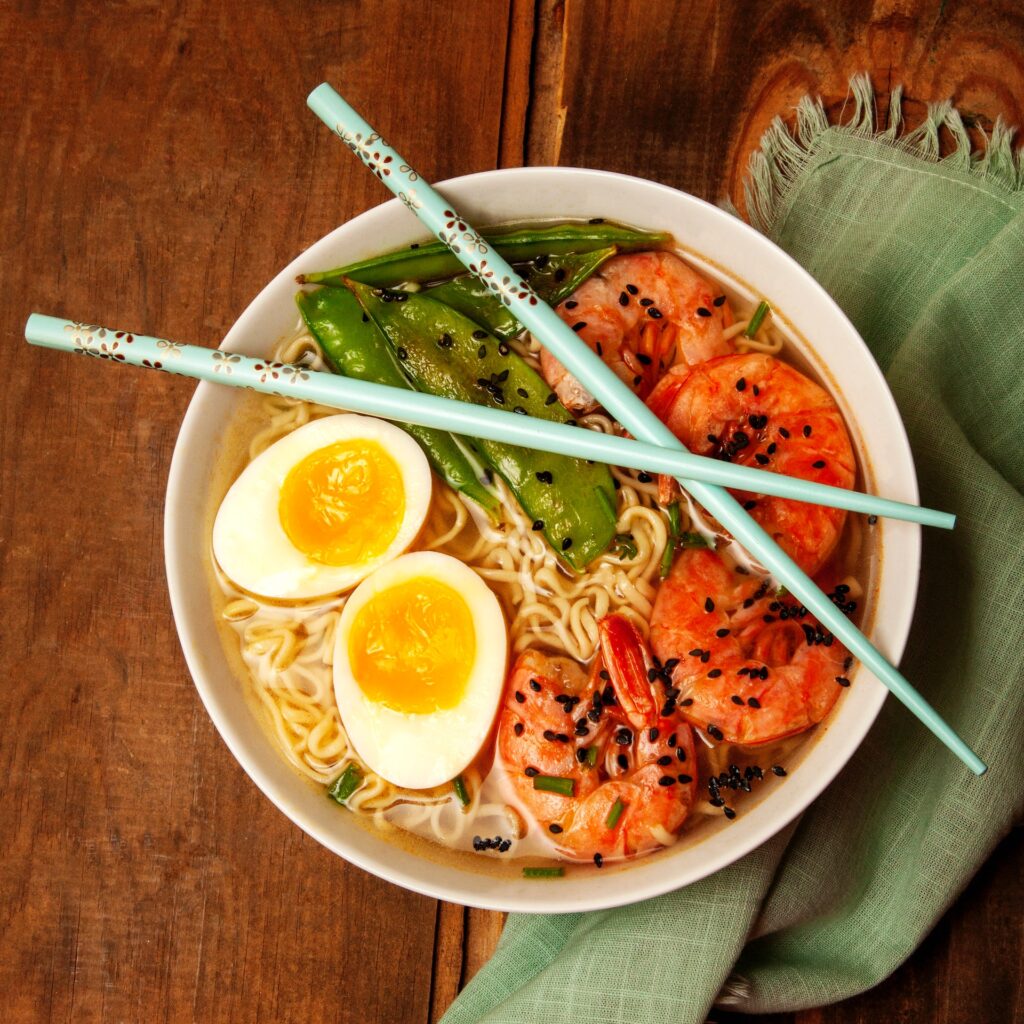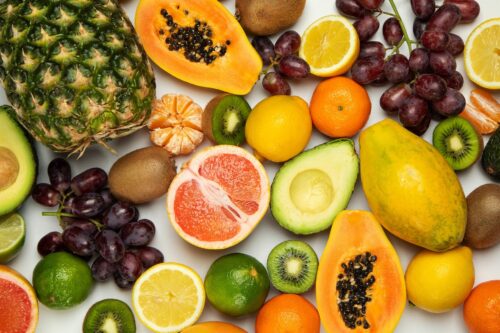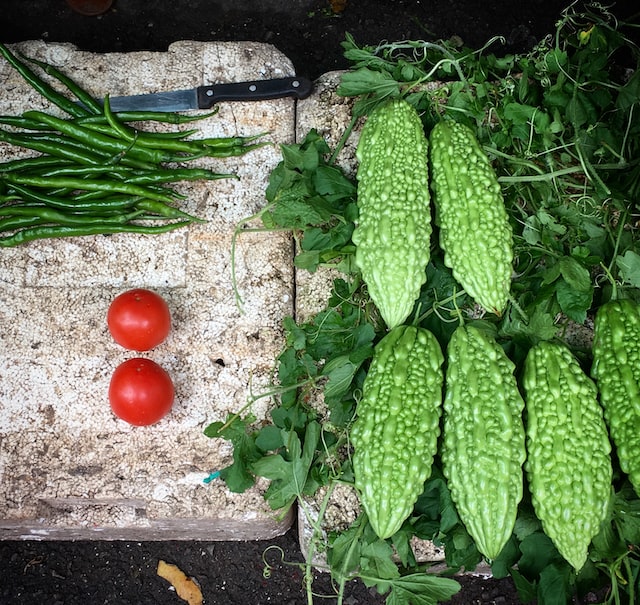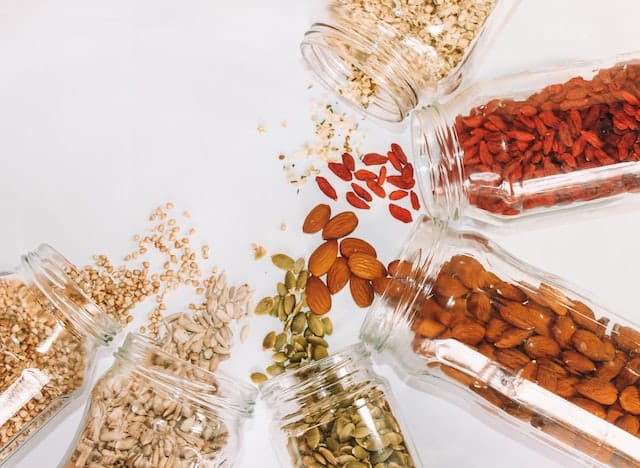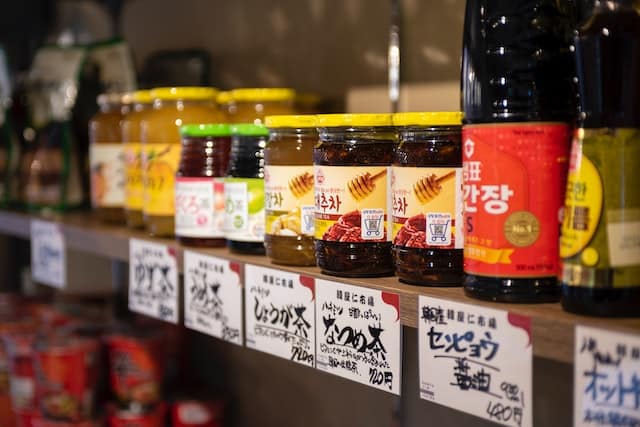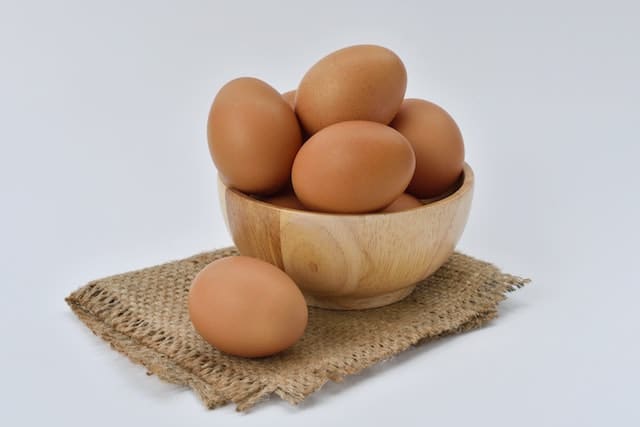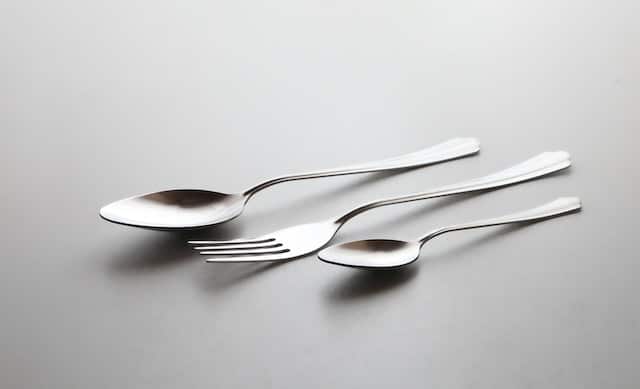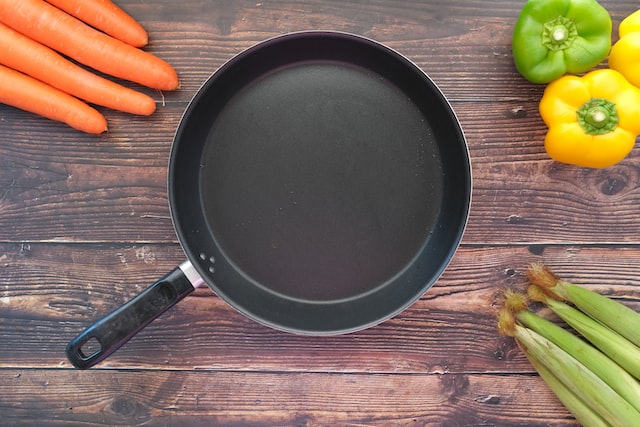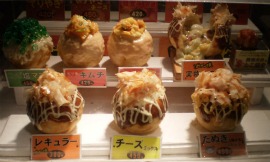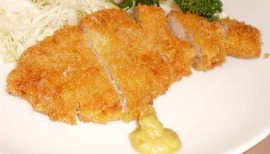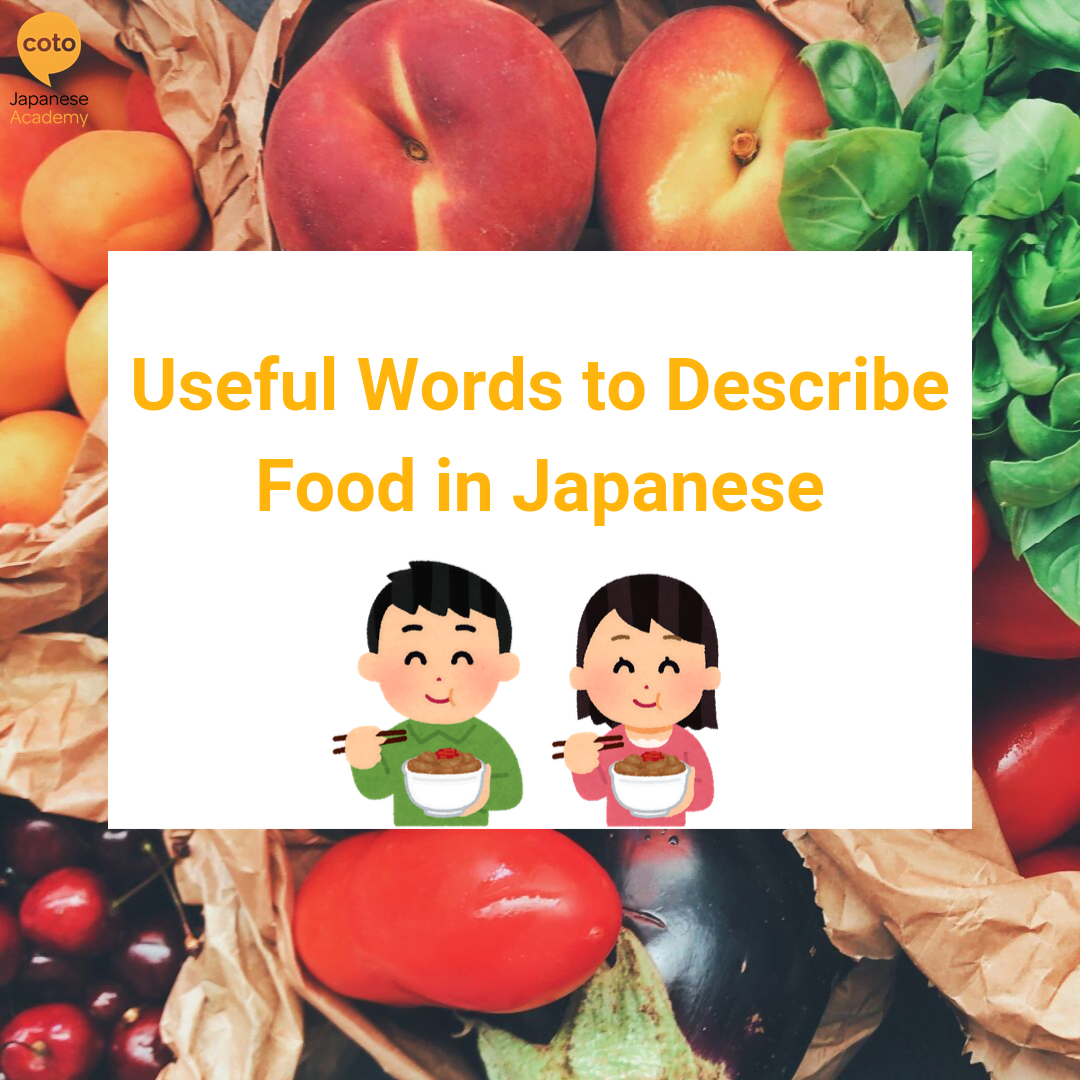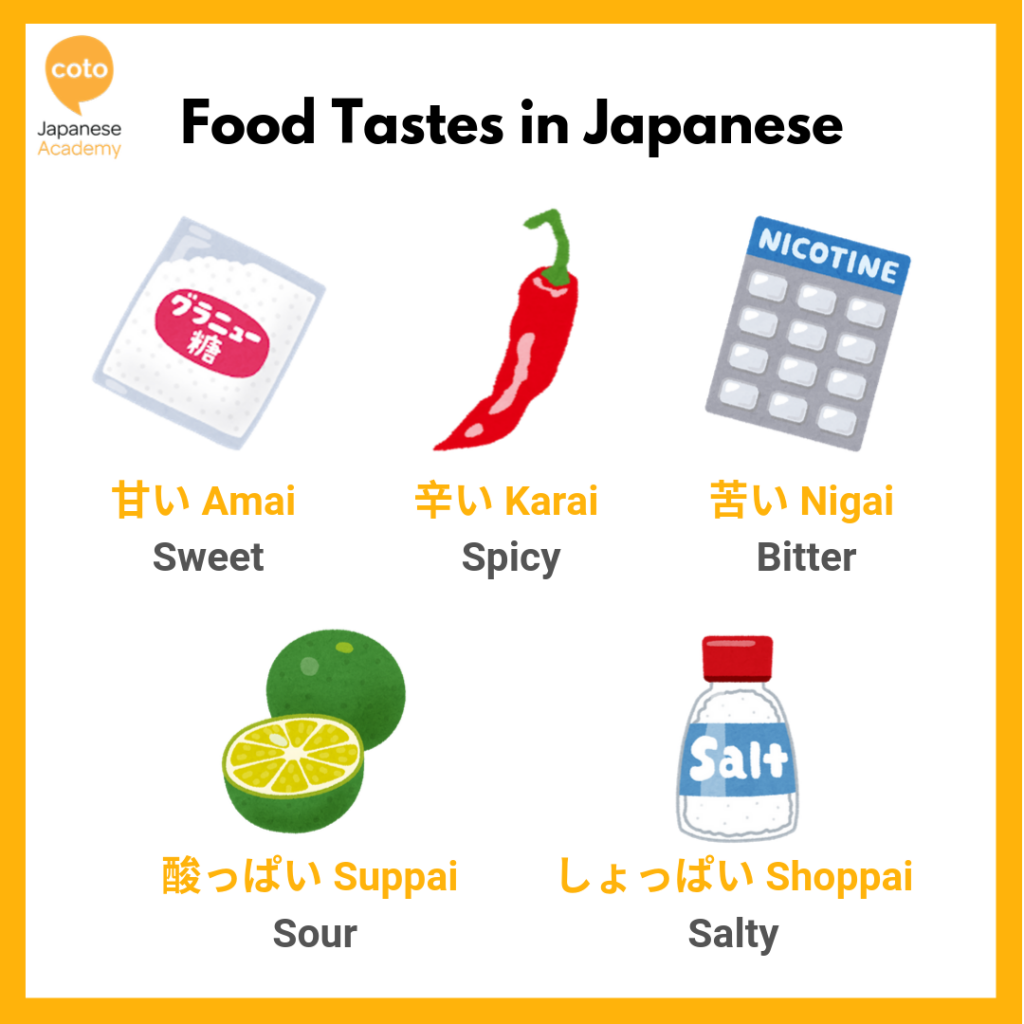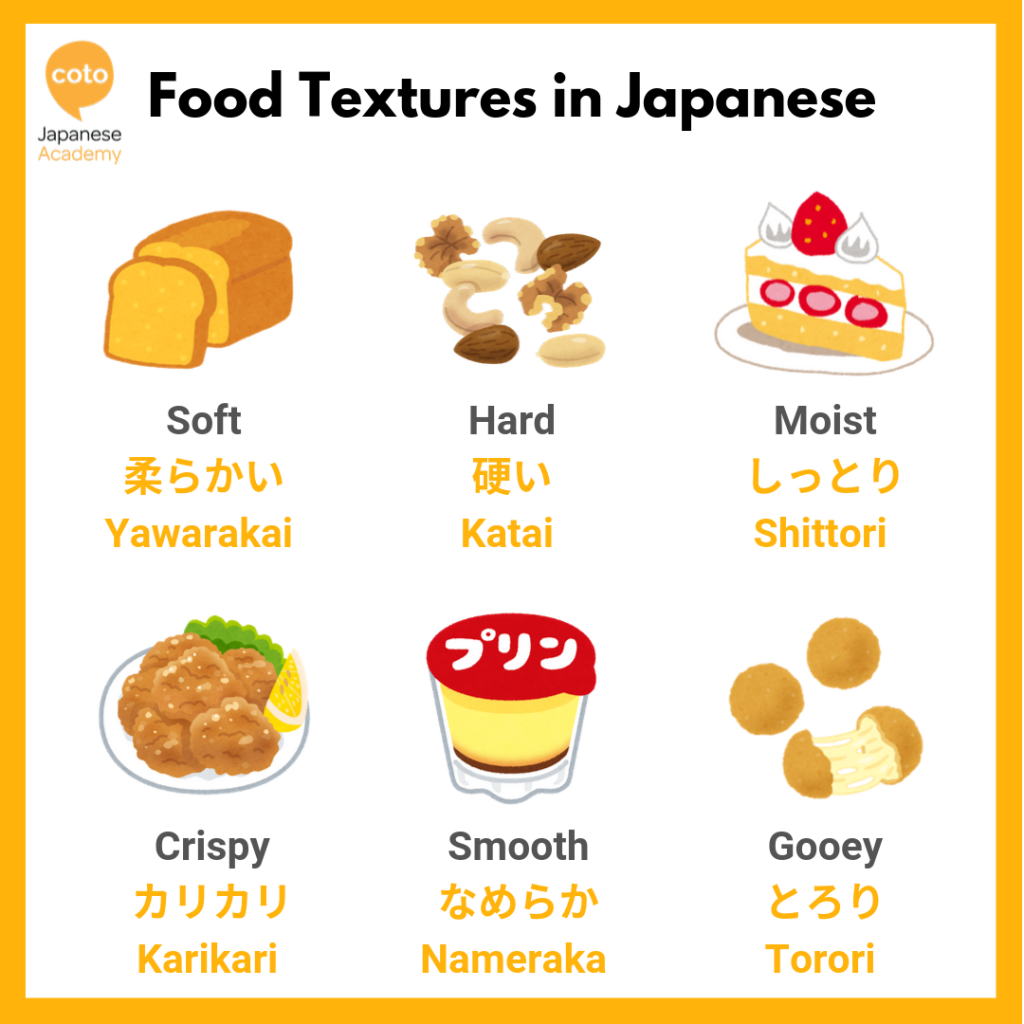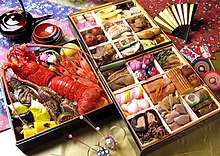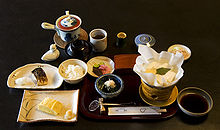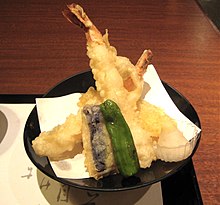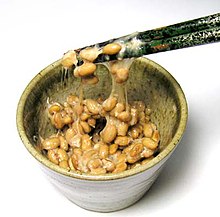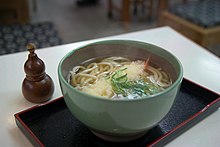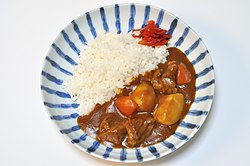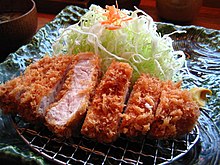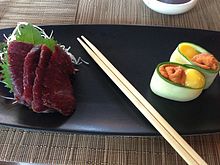Both borrowed words and native words are commonly used for food items in Japanese, and many foods are called by both the native and English-derived terms, in which case the more common/established of the two will be the one used here.
フルーツ(Furuutsu)/Fruit
| Kana | Romaji | English |
| りんご | ringo | apple |
| ぶどう | budou | grapes |
| なし | nashi | Japanese pear |
| ようなし | younashi | (western) pear |
| かき | kaki | persimmon |
| オレンジ | orenji | orange |
| レモン | remon | lemon |
| ライム | raimu | lime |
| グレープフルーツ | gureepufuruutsu | grapefruit |
| バナナ | banana | banana |
| いちご | ichigo | strawberry |
| ブルーベリー | buruuberii | blueberry |
| さくらんぼ | sakuranbo | cherry |
| メロン | melon | green melon (honeydew) |
| すいか | suika | watermelon |
Random tidbit: Japanese apples are much larger than western apples, while the watermelons are rather small.
やさい(Yasai)/Vegetables
| Kana | Romaji | English |
| にんじん | ninjin | carrots |
| セロリ | serori | celery |
| レタス | retasu | lettuce |
| キャベツ | kyabetsu | cabbage |
| トマト | tomato | tomato |
| ねぎ | negi | green onion (scallions) |
| たまねぎ | tamanegi | (round) onion |
| ポテト | poteto | potatoes |
| ブロッコリー | burokkorii | broccoli |
| ピーマン | piiman | bell pepper, green pepper (Fr. piment) |
| まめ | mame | beans (in general) |
| ピース | piisu | peas |
| コーン | koon | corn |
Japanese cuisine uses a lot of vegetables, including many that are unknown in the west. One Japanese vegetable you might be aware of is the daikon, which is a giant white radish.
にくとシーフード(Niku to Shiifuudo)/Meat and Seafood
| Kana | Romaji | English |
| ぎゅうにく | gyuuniku | beef |
| ぶたにく | butaniku | pork |
| ハム | hamu | ham |
| とりにく | toriniku | chicken |
| たまご | tamago | egg |
| さかな | sakana | fish |
| えび | ebi | shrimp, prawn, lobster |
| かに | kani | crab |
| たこ | tako | octopus |
Tori «bird» is used to refer to chicken in the context of food, since turkey and other poultry is rarely found in Japan. Similarly, niku «meat» without further specification usually refers to beef, though butaniku (pork) is cheaper and consumed in greater quantity.
And of course, let’s not forget toufu (soy bean curd), which by itself is mostly flavorless but easily absorbs the flavor of anything it’s cooked with. In Japan it’s not just a vegetarian food, but a regular ingredient in Japanese cuisine.
にゅうせいひん(Nyuuseihin)/Dairy Products
| Kana | Romaji | English |
| ぎゅうにゅう・ミルク | gyuunyuu/miruku | milk |
| チーズ | chiizu | cheese |
| ヨーグルト | yooguruto | yogurt |
| アイスクリーム | aisukuriimu | ice cream |
Dairy products are not used in traditional Japanese cuisine, but they can still be found in Japanese supermarkets and in western food. Both gyuunyuu and miruku are common words for milk.
こめとめんとパン(Kome to Men to Pan)/Rice, Noodles, Bread
| Kana | Romaji | English |
| こめ | kome | rice (uncooked) |
| ごはん | gohan | rice (cooked) |
| げんまい | genmai | brown rice |
| うどん | udon | udon (wheat noodles) |
| そうめん | soumen | somen (thin noodles) |
| そば | soba | soba (buckwheat noodles) |
| ラーメン | raamen | ramen (Chinese noodles) |
| パン | pan | bread, rolls, pastries |
| かしパン | kashipan | sweet bread, pastries |
| ピザ | piza | pizza |
Several notes this time:
- Japanese rice is short grain, as opposed to the long grain rice usually used in the west. Short grain rice is somewhat sticky and clumps together, making it easy to eat with chopsticks.
- Japanese noodles, especially somen and soba, can be served hot in a soup or cold with a dipping sauce. Noodle dishes are a popular lunch food in Japan.
- The «ramen» that we know is really just instant noodles. Real ramen is a Chinese-style Japanese noodle soup with real broth and various toppings that vary by region.
- Pan in Japanese can refer to any sort of bread or pastry, and is more of a snack than a staple meal item.
のみもの(Nomimono)/Drinks
| Kana | Romaji | English |
| みず | mizu | water |
| おちゃ | ocha | green tea, tea in general |
| にほんちゃ | nihoncha | Japanese green tea |
| むぎちゃ | mugicha | Japanese iced barley tea |
| こうちゃ | koucha | black tea (lit. «crimson tea») |
| コーヒー | koohii | coffee |
| ぎゅうにゅう・ミルク | gyuunyuu/miruku | milk |
| ジュース | juusu | juice |
| オレンジジュース | orenjijuusu | orange juice |
| レモネード | remoneedo | lemonade |
| ソーダ | sooda | soda, pop |
| おさけ | osake | sake (rice wine), alcohol in general |
| にほんしゅ | nihonshu | Japanese sake |
| ワイン | wain | wine |
| ビール | biiru | beer |
As you might expect, Japanese people drink a lot of tea, both green and other varieties, not necessarily with meals, but often alone or with snacks.
Koohii for coffee was coined back when «f» was transcribed as «h» in borrowed words, giving ハ、ヒ、フ、ヘ、ホ rather than the more modern ファ、フィ、フ、フェ、フォ.
ちょうみりょうとやくみ(Chomiryou to Yakumi)/Seasonings and Condiments
| Kana | Romaji | English |
| しょうゆ | shouyu | soy sauce |
| あぶら | abura | oil |
| す | su | vinegar |
| みりん | mirin | sweet cooking sake |
| しお | shio | salt |
| こしょう | koshou | pepper |
| さとう | satou | sugar |
| わさび | wasabi | wasabi (Japanese «horseradish») |
| ごま | goma | sesame seeds |
| バター | bataa | butter |
| ケチャップ | kechappu | ketchup |
Real wasabi is a grated root; the green paste found outside of Japan is a cheaper substitute made from horseradish and mustard, two related plants.
わしょく(Washoku)/Japanese Food
| Kana | Romaji | English |
| すし | sushi | sushi (sweet vinegared rice with raw seafood, in various shapes) |
| さしみ | sashimi | sashimi (thinly sliced raw fish over sushi rice) |
| てんぷら | tenpura | tempura (battered and fried vegetables and seafood) |
| やきとり | yakitori | yakitori (grilled chicken skewers) |
| やきにく | yakiniku | yakiniku (grilled beef and vegetables) |
| やきざかな | yakizakana | grilled fish |
| やきそば | yakisoba | yakisoba (fried noodles, usually udon or ramen-like, with ham/sausage and vegetables) |
| すきやき | sukiyaki | sukiyaki (too difficult to explain here) |
| おこのみやき | okonomiyaki | okonomiyaki («Japanese pancakes», with meat or seafood and vegetables inside) |
| とんかつ | tonkatsu | fried pork cutlet |
| カレー・カレーライス | karee/karee raisu | Japanese curry with rice |
| コロッケ | kurokke | croquette (fried mashed potato patty with meat/seafood/vegetables) |
| ぎょうざ | gyouza | Chinese style fried dumplings (potstickers) |
| みそしる | misoshiru | miso soup (miso is a soy-based paste) |
| つけもの | tsukemono | Japanese pickles |
This particular list is far from complete, but includes a number of items that are familiar to westerners or otherwise easy to understand.
Yaki, from the verb yaku, can refer to frying, grilling, baking, or any similar cooking methods that apply direct heat. In contrast, there are several words that translate as «to steam», each for a different food item. Boiling, steaming, and other less fiery cooking methods are used more in Japanese cuisine than in western cooking.
Most meat-based dishes only originated in the last century or so, since consumption of meat was banned for most of Japanese written history.
Although not strictly native to Japan, Japanese karee is quite unlike Indian-style curry and definitely unique to Japan.
ようしょく(Youshoku)/Western Food
| Kana | Romaji | English |
| スープ | suupu | soup (any kind) |
| サラダ | sarada | salad |
| サンドイッチ | sandoitchi | sandwich |
| ハンバーガー | hanbaagaa | hamburger |
| ホットドッグ | hottodoggu | hotdog |
| フライドポテト | furaidopoteto | fries, fried potatoes |
| フライドチキン | furaidochikin | fried chicken |
| ステーキ | suteeki | steak |
| ピザ | piza | pizza |
| スパゲッティー | supgettii | spaghetti |
Note that despite the similar names, Japanese versions of western foods are typically adapted to Japanese tastes, with results like pizza with corn as a topping.
おやつとおかし(Oyatsu to Okashi)/Snacks and Sweets
| Kana | Romaji | English |
| チップ | chippu | chips |
| ポップコーン | poppukoon | popcorn |
| クッキー | kukkii | cookies |
| ケーキ | keeki | cake |
| パイ | pai | pie |
| アイスクリーム | aisukuriimu | ice cream |
| チョコレート | chokoreeto | chocolate |
| ゼリー | zerii | jelly (gelatin and similar desserts) |
| わがし | wagashi | traditional Japanese sweets (many of which are cracker-like) |
Dessert is not traditionally served after meals in Japan (except possibly fresh fruit), but sweet foods are eaten as snacks.
Having trouble understanding something? Anything I’ve missed? Please send your feedback using the contact form and help me improve this site. All questions, comments, and corrections are welcome.
By
Last updated:
March 17, 2023
Did you know that learning to cook in a foreign language is an amazing way to learn said language?
Memorizing Japanese words for food could be your shortcut to fluency.
Read on to learn 150 Japanese food words to describe your favorite dishes!
Contents
- Ingredients: 食材 (shokuzai)
-
- Fruit: 果物 (kudamono)
- Vegetables and Herbs: 野菜 (yasai) and ハーブ (hābu)
- Nuts and Grains: 木の実と穀物 (konomi to kokumotsu)
- Condiments: 調味料 (chōmiryō)
- Animal Products: 畜産物 (chikusanbutsu)
- Making Pastries: お菓子作り (okashizukuri)
- Counters: 助数詞 (josūshi)
- Preparation: 作り方 (tsukurikata)
-
- To Cook: 料理をする (ryōri o suru)
- Utensils/Tools 道具 (dōgu)
- Let’s Cook!: 料理をしよう!(りょうりをしよう!)
- How to Learn Japanese Through Cooking
Download:
This blog post is available as a convenient and portable PDF that you
can take anywhere.
Click here to get a copy. (Download)
Ingredients: 食材 (shokuzai)
Fruit: 果物 (kudamono)
apple: りんご (ringo)
citron: 柚子 (yuzu)
柚子 is a Japanese citrus fruit most closely related to lemons, but with a sweeter and more floral taste. Once the hot weather hits, you’ll find 柚子 everywhere and in everything.
fig: 無花果 (ichijiku)
strawberry: 苺 (ichigo)
watermelon: 西瓜 (suika)
cucumber: きゅうり(kyūri)
grape(s): 葡萄 (budō)
Vegetables and Herbs: 野菜 (yasai) and ハーブ (hābu)
pumpkins: 南瓜 (kabocha)
mushrooms: 榎茸 (enoki dake)
eggplant: 茄子 (nasu)
carrot: 人参 (ninjin)
lotus root: 蓮根 (renkon) or 蓮 (hasu)
ginger: 生姜 (shōga)
bell pepper: ピーマン (pīman)
potato: じゃがいも (jagaimo)
いも by itself refers to tubers related to potatoes (like yams, sweet potatoes, taro root and so on). じゃがいも is one of the more common types. さつまいも are Japanese sweet potatoes: purple on the outside and yellow on the inside, unlike the American orange variety.
garlic: にんにく(ninniku)
perilla, Japanese mint: しそ (shiso)
Where we have peppermint, spearmint and regular mint in the States, they have しそ in Japan. The flavor is closer to spearmint, or even basil, than peppermint, and the herb is popularly served battered and deep-fried or wrapped up in red meat and grilled.
onion: 玉ねぎ (tamanegi)
scallion: ねぎ or 長ねぎ (negi) or (naga negi)
red pepper or chili pepper: 唐辛子 (tōgarashi) or パプリカ (papurika)
shishito pepper: 獅子唐 (shishi tō)
獅子唐 is a type of Japanese sweet pepper, like a small, green bell pepper. These are best grilled over charcoal.
Nuts and Grains: 木の実と穀物 (konomi to kokumotsu)
rice: 米 (kome)
uncooked rice: 米 (kome)
cooked rice: ご飯 (gohan) or 飯 (meshi)
As the Inuit are said to have many words for “snow,” Japan has many words for “rice.” Raw, uncooked grain is generally 米, and different strains of the crop are variations on that word. ご飯 and 飯 are the same word, pronounced differently.
sesame seeds: 胡麻 (goma)
walnuts: 胡桃 (kurumi)
oats: 麦 (mugi)
chestnuts: 栗 (kuri)
麦 also refers to barley and wheat.
Condiments: 調味料 (chōmiryō)
If you want to cook in Japan, some things you’ll definitely need in your kitchen are:
soy sauce: 醤油 (shōyu)
rice wine vinegar: みりん (mirin)
sesame oil: 胡麻油 (goma abura)
vegetable oil: サラダ油 (sarada abura)
water: 水 (mizu)
sauce: たれ (tare) or ソース (sōsu)
broth: 出汁 (dashi)
rice wine: 酒 (sake) or 日本酒 (nihonshu)
olive oil: オリーブ油 (orību abura)
salt: 塩 (shio)
black pepper: 胡椒 (koshō)
Japanese pepper: 山椒 (sanshō)
vinegar: 酢 (su)
mustard: 辛子 (karashi)
honey: 蜂蜜 (hachimitsu)
蜂蜜 is a compound of 蜂, “wasp” or “bee,” and 蜜, “nectar.” If you reverse the characters, 蜜蜂 (mitsubachi), you end up with “honeybee.” I’ll pass on the honeybee cake, thank you.
oyster sauce: オイスターソース (oisutāsōsu)
wine: ワイン (wain)
white wine: 白ワイン (shiro wain)
red wine: 赤ワイン (aka wain)
Animal Products: 畜産物 (chikusanbutsu)
When it comes to eating living things, Japan is far from squeamish. In some restaurants, they even serve fish sperm, which looks like mayo.
For meat eaters, the must-see spots are Japanese grills and chicken barbecue restaurants, where they’ll serve every part of any animal they can find.
gelatin: ゼラチン (zerachin)
egg: 卵 (tamago)
egg yolk: 卵黄 (ranō)
egg white: 卵白 (ranpaku)
milk: ミルク (miruku) or 牛乳 (gyūnyū)
condensed milk: 練乳 (rennyū)
mentaiko, seasoned pollack roe: 明太子 (mentaiko)
bonito flakes: かつお節 (katsuobushi)
unsalted butter: 無塩バター (muen batā)
salted butter: 有塩バター (yūen batā)
cream: 生クリーム (namakurīmu)
meat: 肉 (niku)
ground meat: ひき肉 (hikiniku)
chicken: 鶏肉 (toriniku)
chicken wings: 手羽先 (tebasaki)
chicken tender: ささ身 (sasami)
fish: 魚 (sakana)
mackerel: 鯖 (saba)
shrimp: 海老 (ebi)
oyster: 牡蠣 (kaki)
clam: あさり(asari)
pork: 豚肉 (butaniku)
beef: 牛肉 (gyūniku)
chicken gizzard: 砂肝 (sunagimo)
I once made the mistake of buying 砂肝. The name is a compound of 砂, “sand,” and 肝, “liver,” but I ended up completely ignoring the other half-dozen characters on the package, and I just zeroed in on “liver.”
I had never had chicken liver before! Imagine my disappointment when I bit into a piece of gizzard, the texture of which is diametrically opposite that of liver, and promptly tossed it all into the garbage.
pork bone: 豚骨 (tonkotsu)
豚骨 is the standard base for Japanese ramen, and it produces a rich, heavy, oily and milky broth… it’s like heaven in my mouth.
cartilage: 軟骨 (nankotsu)
quail: うずら (uzura)
Quail isn’t something you see every day, but in Japan they love quail eggs, うずらの卵 (うずらの たまご), and you’ll often find them steamed (like tea eggs) or grilled, skewered and wrapped in bacon.
sausage: ソーセージ (sōsēji)
tsukune: つくね (tsukune)
つくね is a Japanese meat ball, usually made from poultry instead of red meat.
Making Pastries: お菓子作り (okashizukuri)
There are traditional Japanese sweets, but Japan is far more enamored with French and German pastries, and everywhere you go, you’ll find a French patissier or a bread baker.
However, though European sweets are popular, baking at home is not and many people don’t have the space to bake (Japanese kitchens are small, and their ovens minuscule).
As a result, finding ingredients can be difficult, and finding them in appropriate quantities a pain.
agar-agar: 寒天 (kanten)
寒天 is a gelatin obtained from seaweed (and thus a good substitute in vegan baking), used in pastry as a binder and thickener.
granulated sugar: グラニュー糖 (guranyūtō)
brown sugar: 黒砂糖 (kurozatō)
light brown sugar: きび砂糖 (ki bi satō)
powdered sugar: 粉砂糖 (kona satō)
wheat flour: 麦粉 (mugiko) or 小麦粉 (komugiko)
Japanese flours, 麦粉, are named according to the amount of protein: “strong” refers to bread flour (強力粉, きょうりき こ), “medium” (中力粉, ちゅうりき こ) would be all-purpose and “weak” is cake or pastry flour (薄力粉, はくりき こ).
roasted soybean flour: きな粉 (kinako)
きな粉 is a nutty, flavorful, light brown flour used for dusting Japanese confections or adding flavor to sweets. It’s not the same as soy flour.
rice flour: 米粉 (komeko)
Like different types of 米, there are different types of 米粉: 餅粉 (もちこ) is a sticky rice flour used in making sticky rice buns, 餅 (もち), and often used in gluten-free baking. It can also be called 団子粉 (だんごこ). 玄米粉 (げんまいこ) is the brown, fibrous sister of 餅粉: brown rice flour.
amazake: 甘酒 (amazake)
甘酒 is sweet rice wine used in cooking or baking, or just drinking.
whole wheat flour: 全粒粉 (zenryūko)
almond flour: アーモンドプードル (āmondo pūdoru)
Not “poodle,” but poudre, from French.
potato starch: 片栗粉 (katakuriko)
cocoa powder: ココアパウダー (kokoa paudā)
yeast: イースト (īsuto)
baking powder: ベーキングパウダー (bēkingupaudā)
caramel: キャラメル (kyarameru)
vanilla essence: バニラエッセンス (banira essensu)
poppy seeds: 芥子粒 (keshitsubu)
cinnamon: シナモン (shinamon)
cardamom: カルダモン (karudamon)
star anise: 八角 (hakkaku) or アニス (anisu)
soy milk: 豆乳 (tōnyū)
sweet red bean paste: 餡子 (anko)
Counters: 助数詞 (josūshi)
teaspoon: 小さじ (kosaji)
tablespoon: 大さじ (ōsaji)
piece: 個 (ko)
This can be used for eggs, fruit or things that are generally just measured by numbers without amounts.
small piece, seed, drop: 粒 (tsubu)
can: 缶 (kan)
sheets, leaves: 枚 (mai)
slices/pieces (of meat): 切れ (kire)
sticks, stalks: 本 (hon)
This is the counter for long, round things like stalks of asparagus.
Preparation: 作り方 (tsukurikata)
To Cook: 料理をする (ryōri o suru)
to fry, grill, roast, bake: 焼く (yaku)
In the case of rice or noodles (“fried rice,” “stir-fried noodles” and so on), this means “to stir-fry” or “to pan fry.”
The next verb below is used with meat, vegetables and sautéing. 焼く is for baking pastries, frying pancakes or omelets, grilling, roasting in the oven, pan searing (steak, etc.) and the aforementioned stir-fried noodles and rice.
to stir-fry: 炒める (itameru)
to deep fry: 揚げる (ageru)
to steam: 蒸かす (fukasu)
to cut: 切る (kiru)
to heat: 熱する (netsu suru)
to pre-heat: 予熱をする (o suru)
to turn off the stove: 火を止める (hi o tomeru)
to mix together: 混ぜる (mazeru)
to serve: 盛り付ける (moritsukeru)
to grate (ginger, sesame seeds, etc.): 卸す (orosu)
to add: 加える (kuwaeru)
to boil: 茹でる (yuderu)
to stew, simmer, boil: 煮る (niru)
茹でる and 煮る both mean “to boil,” but the former implies cooking an object in boiling liquid: e.g., hard-boiled eggs, 茹で卵 (ゆでたまご). The latter means “to boil” or “to simmer” a liquid, either with the goal of reducing it (stews and braises) or cooking what’s inside.
to come to a simmer: 煮立つ (nitatsu)
煮立つ, is the intransitive verb: the stew “boils” or “comes to a simmer.”
Utensils/Tools 道具 (dōgu)
skillet: フライパン (furaipan)
knife: 包丁 (hō chō) or ナイフ (naifu)
rubber spatula: ゴムベラ (gomu bera)
strainer: こし器 (koshiki)
whisk: 泡立て器 (awadateki)
baking sheet or jelly roll pan: バット (batto) or オーブン用鉄板 (ōbunyō teppan)
parchment paper: オーブンシート (ōbun shīto) or クッキングシート (kukkingu shīto)
Let’s Cook!: 料理をしよう!(りょうりをしよう!)
Much of modern Japanese cooking is foreign-inspired, but all of it is simple. The recipe below is a personal favorite.
See if you can decipher the instructions with your new knowledge of food vocabulary! In some places, hiragana have been added in parentheses next to words, in order to give you a helping hand.
豚肉の生姜焼き (butaniku no shōgayaki)
Ginger Pork
2人分 (ふたりぶん)
serves 2
食材
Ingredients
豚のロース肉 (ぶたの ろーす にく):250〜300g
The above is a thin slice of pork loin used for quick grilling and frying.
玉ねぎ:1/2 個
卸し生姜:大さじ2
醤油:大さじ2
酒:大さじ2
グラニュー糖:大さじ1
サラダ油:大さじ2
小麦粉:小さじ1
作り方
Directions
玉ねぎの皮 (かわ) をむき、半分 (はんぶん) にする。薄く (うすく) (5mmぐらい) 切る。
Remove the onion skin and cut the onion in half. Slice the onion thinly (about 5-millimeter slices).
生姜は、皮をむき、卸す。
Peel and grate the ginger.
バットに生姜、醤油、酒とグラニュー糖を入れて (いれて) 混ぜ、豚肉を広げて (ひろげて) 入れる。全部 (ぜんぶ) を混ぜ、約5分 (やく ごふん) 置いて (おいて) おく。
Put the ginger, soy sauce, rice wine and sugar into a small baking pan and mix it together. Spread the pork in the sauce and mix. Let it marinate for about 5 minutes.
フライパンにサラダ油を入れて、中火 (ちゅうび) で熱し、豚肉をざっと広げて入れる。
Heat the oil in the skillet on medium heat, and spread the pork out in the pan.
小麦粉も加え、そのまま2〜3分間 (に、さん ぷんかん) 焼き、肉の色 (いろ) が変わった (かわった) ら、玉ねぎも加える。
Add the flour and let the pork cook for 2-3 minutes, until the color starts to change, then add the onion.
バットに残っている (のこっている) たれを加え、弱火 (よわび) で焼き続ける (やきつづける)。
Pour in the remaining sauce from the baking pan, and continue cooking on low heat.
たれがほとんどなくなったら、盛り付ける。
When the sauce is almost all evaporated, turn off the heat and transfer the pork to a serving dish. (“Serve it.”)
How to Learn Japanese Through Cooking
Once you’re armed with a handy dandy dictionary, smartphone dictionary app or online translation tool, get yourself into the kitchen!
Actually, sit yourself down on the couch, with your computer. Let’s learn Japanese culinarily by:
- Getting a subscription to the Kawaii Box. It’s a sweet little box of Japanese cuteness that often contains one or two Japanese snacks, and sometimes a nifty little gadget that can be used for cooking, eating or playing with your food.
- Watching Japanese variety shows. They talk about food a lot. Rachel Ray’s not so popular, but they have their own share of cooking segments.
- Reading food blogs, like Ruu No Oishii Gohan, Sake To Ryouri or Cafe&Meal Muji. By following Japanese bloggers, we’ll feed two birds with one stone fruit: learning the language and learning to cook!
- Perusing a Japanese recipe database, like Rakuten Recipes, Gourmet Navigator (GuruNavi) or Japanese CookPad.
- Filling up our shopping carts with Japanese cookbooks.
If you prefer getting instructions directly in Japanese with interactive subtitles, you can do so on FluentU, a language learning program.
FluentU uses authentic content such as music videos, movie clips and instructional videos on how to talk about your favorite dishes in Japanese. There are also features such as personalized quizzes and flashcards.
You can use the FluentU website or the iOS and Android apps to learn on the go.
どうぞお召し上がりください!
Bon appétit!
Download:
This blog post is available as a convenient and portable PDF that you
can take anywhere.
Click here to get a copy. (Download)
`
You are here: Home/ Featured Posts/ 30+ Essential Japanese Words to Describe Food
Do you want to sound like a connoisseur of food in Japanese? Then let’s learn a medley of Japanese words and idioms in this post that describe the taste of food!
Other Posts:
- 50+ Japanese Words and Idioms about Love/Romance
- Japanese Money-Related Idioms and Slang Words
Words Meaning “Tasty”
- おいしい (also 美味しい): tasty, delicious
- うまい (also 美味い): tasty, yummy (casual);
- うめえ (more casual and masculine than うまい)
- コク/うま味(み)がある: have a deep/umami-flavour
- 絶品(ぜっぴん): one-of-a-kind food
- ジューシー: juicy
(Trivia) Former Prime Minister Shinzo Abe often used “juicy” to describe the taste of food, including tomato, beef, peach, melon, cucumber and grape. Just in case you are very keen to see him saying “juicy”, I’ve attached the YouTube video below where he describes many types of food as “juicy”.
Words Meaning “Taste Bad”
- 美味(おい)しくない: not tasty
- 私の好みではない: not my favourite/cup of tea
- 口(くち)に合(あ)わない : “does not suit my mouth” = not my cup of tea
- 不味(まず)い: taste bad
- 味(あじ)がしない: taste nothing
- ぬるい, 冷(さ)めた: lukewarm (not hot enough)
Intensifiers
- とても, とっても, かなり: “very”
(e.g.) とても/とっても/かなり美味しい
- めっちゃ: “very/really” (casual)
(e.g.) めっちゃおいしい/まずい
- 超 (ちょう, casual), 超絶 (ちょうぜつ, very casual/young): “very/really”
(e.g.) 超おいしい, うまい/まずい, 超絶おいしい, うまい/まずい
- マジ: “very/really” (casual)
(e.g.) マジうまい/まずい
- 激 (げき): “very/really” (casual)
(e.g.) 激ウマ (really good)、激マズ (really bad), 激辛 (げきから, extremely spicy)
- クソ: “bloody”, “goddamn” “af” (very casual)
(e.g.) クソうまい (bloody good)、クソマズい (taste like sh*t)
- 全然 (zenzen): very, unexpectedly
See the post below.
Meaning of 全然 (Zenzen) Without a Negative Form ない (Nai)
Specific Taste
- 甘(あま)い: sweet
- 甘(あま)ったるい: too sweet
- 酸(す)っぱい: sour
- 辛(から)い: hot/spicy; ピリ辛(から)/激辛 (げきから): a bit/extremely spicy
- しょっぱい: too salty
- 苦(にが)い: bitter
- 濃(こ)い, こってり: thick, heavy taste (e.g. こってりラーメン)
- 薄(うす)い (negative), さっぱり (positive): light taste
Soggy Noodles: 麺が伸びる
麺 (めん) が伸(の)びる literally means “(the noodles) get longer”, but actually means that the noodles “absorb water and become soggy”. The subject “麺が” is often omitted as in the second example below.
(e.g.)
麺が伸びるから、ゲームやめて食(た)べなさい!
The noodles will get soggy, so stop playing the game and eat them now!
伸びる前(まえ)に、どうぞ召(め)し上(あ)がってください!
I recommend you would eat the noodles before they get soggy!
* 召し上がる: sonkeigo of 食べる (eat)
Onomatopoeia
- ふわふわ: fluffy
- トロトロ: creamy
- モチモチ: like a mochi, chewy
- カリカリ, サクサク, シャキシャキ: crispy
(シャキシャキ is often used for a salad, and サクサク for snacks and cookies)
Japanese Idioms Related to Food
舌鼓を打つ
“舌鼓(したつづみ or したづつみ) を 打(う)つ” literally means ‘hit a “tongue-drum”‘, where 鼓 (つづみ) is a Japanese traditional hand drum. It figuratively means “you’re really impressed by the taste of food (and that makes you click your tongue)”. It is usually used in writing only, but you may use it in a conversation to describe delicious food in a joking and exaggerated way.
昨日 (きのう) は旅館(りょかん)の海鮮料理(かいせんりょうり)に舌鼓を打った
Yesterday, I “hit a tongue-drum” for (= was really impressed by/fully enjoyed the taste of) the seafood served at the ryokan (a Japanese-style hotel).
絵に描いた餅
絵(え)に描(か)いた餅(もち), literally meaning “mochi (Japanese rice cake) you draw on a picture”, is a Japanese idiom that means “(sounds good but) is unrealistic/impractical”, because it looks yummy but you cannot really eat it. It is very similar to the English phrase “pie in the sky” in terms of the meaning and nuance!
日本語 (にほんご) を10日 (か)でマスターするなんて計画 (けいかく)は、絵に描いた餅だ!
The plan to master Japanese in 10 days is a mochi you draw on a picture (the pie in the sky)!
More idioms related to mochi at explained in the following post:
Japanese Idioms about Mochi: 餅 (もち), Japanese Rice Cake!
朝飯前
朝飯前(あさめしまえ)literally means “before breakfast”, but figuratively means “a piece of cake”, “very easy”, i.e. easy enough to do before you eat breakfast. It is often used when someone asks you a favour and you reply to them in a light/casual/humorous way.
(e.g.)
そんなの朝飯前だよ。
That’s a piece of cake (for me).
あのチームに勝(か)つなんて、朝飯前だ。
That’s a piece of cake (for us) to beat the team.
ゴマをする
ゴマをする literally means “grind sesame seeds”, but figuratively means “be a sycophant” or “butter up/suck up to someone”. This idiom is so famous that the gesture of grinding seeds (rotating a closed hand on the palm of the other hand) refers to the act of sucking up to someone. According to one of the theories of the origin, the phrase started to be used to describe those people because ground sesame seeds, which are very sticky and stick to anything, resemble sycophants/brown-nosers tagging along with high-ranking people.
(e.g.)
彼は昇進 (しょうしん) するためなら、進(すす)んでゴマをする人間(にんげん)だ
He is a person who is willing to act obsequiously to get promoted.
See more Japanese idioms related to plants in the following post:
Eat Grass on the Road? Funny Japanese Idioms about Plants
Japanese Kanji Words for Japanese Food
- 寿司 (すし): sushi
- 和牛 (わぎゅう): wagyu; 和(わ) “Japanese” + 牛 (ぎゅう) “beef”
- 居酒屋 (いざかや): izakaya; 居(い)る ”stay” + 酒屋(さかや) “liquor shop”
- 味噌汁(みそ しる): 味噌(miso) + 汁(しる) “soup/liquid”
- 焼(や)き鳥(とり): yakitori; 焼(や)く “grill/fry/roast” + 鳥(とり) “bird/chicken”
- 餅(もち) mochi (Japanese rice cake)
- 抹茶(まっちゃ): matcha
- 蕎麦(そば): soba noodles
- 醤油(しょうゆ): soy sauce
- 牛丼 (ぎゅうどん): beef rice bowl; 丼 (don) = “rice bowl”
- 餃子(ぎょうざ): gyoza (pan-fried dumplings)
- 和食 (わしょく): Japanese food=日本料理 (にほんりょうり)
- 麺(めん) noodles; 麺類 (めんるい) = “types of noodles”
鍋(なべ): nabe, hot-pot
(Note) 鍋 looks similar to 禍 (か) “disaster”, so be careful (e.g. コロナ禍 “coronavirus-disaster”).
See also: A List of Japanese COVID-19 Words and Idioms
Difficult-to-Read Kanji Words for Food
- 海老 (えび): shrimp/prawn
- 小豆(あずき): red beans, adzuki beans
- 大豆(だいず): soybeans
- 納豆(なっとう): natto
- 海苔(のり): seaweed
- 茄子(なす): eggplant
- 素麺 (そうめん): Sōmen noodles
- 蕎麦(そば): soba noodles
- 人参 (にんじん): carrot
(Trivia) Computer machines often misunderstand 外国人参政権 as 外国 (foreign) + 人参 (carrot) + 政権 (government); it should be 外国人 (がいこくじん “foreigner”) + 参政権 (さんせいけん, “right to vote”)
Words for a Meal
- breakfast: 朝食(ちょうしょく)、朝飯(あさめし)、朝(あさ)ごはん
- lunch: 昼飯(ひるめし)、昼(ひる)ごはん、お昼(ひる)、ランチ
- dinner: 晩(ばん)ご飯(はん)、晩飯(ばんめし)、夜(よる)ごはん、夕飯(ゆうはん)、ディナー:
(Note 1): ランチ and ディナー sound like a nice meal (e.g) イタリアンランチ (Italian lunch), 高級(こうきゅう)ディナー (expensive dinner)
(Note 2): 朝飯, 昼飯 and 晩飯 sound more masculine/casual than 朝ごはん, お昼ごはん, and 夜(よる)ごはん
(Note 3): ごはん means not only “meal” but also “rice”. In contrast, おかず means “a dish that comes with rice”. Although おかず is often translated as “a side dish”, it rather refers to a main dish (e.g. beaf/chicken/pork) that Japanese people have with rice.
See Also
Ajimi or Dokumi? Meaning of Japanese Words for Tasting Food
- Home
- Japanese Vocabulary
- Japanese Food
This section covers the words and vocabulary used to describe Japanese food.
The numbers of Japanese restaurants have been growing rapidly around the world over the years.
That’s no wonder Japanese food has becoming more popular in many countries.
In the past when we talked about Japanese dish, the only one popped out was either Sushi or Tempura.
However, Japanese dish is more than Sushi or Tempura. There are many other delicious Japanese dishes that are slowly gaining popularity in the world.
Japanese food is famous for its bland flavor and this could be one of the reasons for longevity of a lot of Japanese.
Let’s get started to learn some dishes of yummy Japanese food.
| Kanji | Hiragana or Katakana |
Romaji | Meaning | |
| 1. | 食べ物 | たべもの | tabe mono | Food |
| 2. | 日本料理 | にほんりょうり | nihon ryouri | Japanese Cooking / Japanese Dish / Japanese Food |
| 3. | 朝食 | ちょうしょく | chou shoku | Breakfast |
| 4. | 朝御飯 | あさごはん | asa gohan | Breakfast |
| 5. | 昼食 | ちゅうしょく | chuu shoku | Lunch |
| 6. | 昼御飯 | ひるごはん | hiru gohan | Lunch |
| 7. | 夕食 | ゆうしょく | yuu shoku | Dinner |
| 8. | 晩御飯 | ばんごはん | ban gohan | Dinner |
| 9. | 夜食 | やしょく | ya shoku | Supper |
| 10. | おかず | okazu | Side Dish | |
| 11. | お八つ | おやつ | oyatsu | Snack / Refreshment |
| 12. | 弁当 | べんとう | bentou | Box Lunch |
| 13. | 駅弁 | えきべん | ekiben | Train Station Box Lunch |
| 14. | 御飯 | ごはん | gohan | Meal / Cooked Rice |
| 15. | 刺身 | さしみ | sashimi | Sliced Raw Fish |
| 16. | 寿司 / 鮨 / 鮓 | すし | sushi | Sushi |
| 17. | 天婦羅 | てんぷら | tenpura | Tempura / Deep-fried Fish and Vegetables |
| 18. | 牛丼 | ぎゅうどん | gyuu don | Rice topped with Beef and Vegetables |
| 19. | 親子丼 | おやこどん | oyako don | Rice topped with Boiled Chicken and Eggs |
| 20. | 天丼 | てんどん | ten don | Rice topped with Deep-fried Prawns & Fishes |
| 21. | 鰻丼 | うなぎどん | unagi don | Rice topped with Glaze-grilled Eel |
| 22. | 鰻 | うなぎ | unagi | Eel |
| 23. | 豚カツ | とんカツ | tonkatsu | Pork Cutlet |
| 24. | カレーライス | kare- raisu | Curry and Rice | |
| 25. | 鋤焼き | すきやき | suki yaki | Thin Slices of Beef cooked with various Vegetables in a Heavy Iron Pan |
| 26. | お好み焼き | おこのみやき | okonomi yaki | Thin and Flat Pancake cooked on a Hot Plate with bits of Meat, Seafood and Chopped Cabbages |
| 27. | 鉄板焼き | てっぱんやき | teppan yaki | Grilled Meat cooked on Iron Plate |
| 28. | 焼き鳥 | やきとり | yaki tori | Grilled Chicken / Broiled Chicken |
| 29. | 蛸焼き | たこやき | tako yaki | Octopus Dumpling |
| 30. | 焼きそば | やきそば | yaki soba | Pan Fried Noodle |
| 31. | 餃子 | ギョウザ | gyouza | Dumpling stuffed with Minced Pork and Vegetables |
| 32. | 茶碗蒸し | ちゃわんむし | chawan mushi | Steamed Egg Custard in Tea Cup |
| 33. | しゃぶしゃぶ | shabu shabu | Japanese Style Hotpot | |
| 34. | 味噌 | みそ | miso | Miso / Bean Paste |
| 35. | 味噌汁 | みそしる | miso shiru | Miso Soup |
| 36. | ラーメン | ra-men | Ramen | |
| 37. | うどん | udon | Noodle made of Wheat Flour | |
| 38. | 蕎麦 | そば | soba | Buckwheat Noodle |
| 39. | 餅 | もち | mochi | Sticky Rice Cake |
| 40. | 餡パン | あんパン | anpan | Japanese Bun filled with Red Bean Paste |
| 41. | 牛肉 | ぎゅうにく | gyuuniku | Beef |
| 42. | 豚肉 | ぶたにく | butaniku | Pork |
| 43. | 鶏肉 | とりにく | toriniku | Chicken Meat |
| 44. | 羊肉 | ようにく | youniku | Mutton / Lamb |
| 45. | 魚 | さかな | sakana | Fish |
| 46. | 海老 / 蝦 | えび | ebi | Prawn / Shrimp |
| 47. | 蟹 | かに | kani | Crab |
| 48. | 豆腐 | とうふ | toufu | Tofu / Bean Curd |
| 49. | 卵 | たまご | tamago | Egg |
| 50. | 食パン | しょくパン | shoku pan | Plain Bread / White Bread |
| 51. | 玉葱 | たまねぎ | tamanegi | Onion |
| 52. | 胡瓜 | きゅうり | kyuuri | Cucumber |
| 53. | 醤油 | しょうゆ | shouyu | Soy Sauce |
| 54. | 酢 | す | su | Vinegar |
| 55. | 山葵 | わさび | wasabi | Japanese Horseradish |
| 56. | 油 | あぶら | abura | Oil |
| 57. | 砂糖 | さとう | satou | Sugar |
| 58. | 塩 | しお | shio | Salt |
| 59. | 胡椒 | こしょう | koshou | Pepper |
| 60. | 調味料 | ちょうみ りょう |
choumi ryou | Seasoning / Condiment / Flavoring / Spices |
There are many more other Japanese food not listed above. I will add more related vocabulary to the list in future.
And if you want to test how many of these foods that you can recognize and call out their Japanese names correctly, make sure you check out this page and let me know the numbers of Japanese foods you can identify.
By the way, this link above is an affiliate link, which means that I would earn a commission if you do end up purchasing the related learning course. It’s at no extra cost to you, and please if you have any questions related to this learning course, please let me know and I would be happy to answer them for you.
Buy me a coffee
Like This Page?
Have you ever wondered why bread is called “pan” in Japanese? If so, you’re not alone.
Given that so many loan words in the Japanese language come from English, and allowing for the way sounds that don’t exist in Japanese are phonetized, you might reasonably expect that the Japanese word for bread would be “bureddo”. So just where did “pan” come from?
In this article, we’ll get to the bottom of the “why is bread called ‘pan’” question while also sharing the surprising origin of the words for a number of other common Japanese food names.
What languages does Japanese borrow from?
According to Margaret Pine Otake, associate professor in the Department of International Language and Culture at Tokyo Seitoku University, 80 to 90% of loan words in the Japanese language today were borrowed from English. But that hasn’t always been the case. A dictionary of the Japanese language published in 1889, she notes, shows more words coming into Japanese from Dutch, with 85 words from Dutch compared to 72 from English.
But the first foreign words adopted in Japan come not from Dutch or English, but from Portuguese. That’s because Japan’s earliest extended exposure to the West began in the mid-16th century, with the arrival of Jesuit priests on a mission from Portugal. And with that contact came the introduction of Western foods and cooking methods.
By now, you’ve probably guessed it: yes, the Japanese word for bread — pan (パン, pronounced “pahn” and written in katakana to distinguish it as a loan word) — comes from the Portuguese word pão, meaning “bread”. It is believed to be one of the earliest words borrowed from a Western language into Japanese.
Other Japanese food names borrowed from Portuguese include tempura (天ぷら and now part of English as “tempura”) and kasutera (カステラ), a still-popular honey sponge cake that’s been made in Japan for over 400 years, based on a recipe for Portuguese “castella” cake.
Japanese Food Names: “Only in Japan” Breads and Mishmash Naming
While the word pan comes from Portuguese, bakers in Japan have never hesitated to combine it with loan words from other languages when coming up with product names for their original creations.
Some of the linguistically mishmashed names for breads you’ll find in Japan include karē-pan (カレーパン), a deep-fried bread filled with curry, a word adopted into Japanese either from English or the Tamil word “kari”; an-pan (
餡パン), sweet-dough rolls filled with a paste of adzuki or other beans known as an, a word that originally came from China; and sōsēji-pan (ソーセージパン, a type of roll in which white-bread dough is baked around a whole small sausage).
Some linguists believe the Japanese word for sausage – sōsēji — originated in the Old French word “saussiche”; others think it was more likely borrowed from English.
Why is green pepper “piman” in Japanese?
What about green pepper? Why is this common vegetable, also called ‘bell pepper” in England and the United States, and “capsicum” in Australia, New Zealand and India, known as pīman (ピーマン) in Japanese?
It’s generally believed this name originates in the French word piment, pronounced “pee-mahn” and meaning “pigment”. But this nomenclature is a bit of a mystery because in France a green bell pepper is generally known as “un poivron vert”.
According to Tetsuta Komatsubara, a professor at the Graduate School of Intercultural Studies, Kobe University, chili peppers were introduced to Japan from Portugal in the 16th century. At that time, foreign products arrived in Nagasaki on ships coming from China, so the spicy new import was somewhat inaccurately named tō-garashi, meaning “Chinese mustard”. That’s a compound formed by joining an existing word for mustard, karashi (からし), with an old-fashioned prefix tō- (唐-, meaning “from China”).
The milder sort of sweet peppers came much later, only during the Meiji period (1868-1912), and from the United States, where they were known as green peppers or bell peppers. It’s not clear why a French-like sound was adopted, Komatsubara notes, but many Japanese mistakenly assume pīman comes from English and try to use it when speaking English, much to the confusion of native English-speaker listeners.
By the way, red and yellow sweet peppers are known in Japan as karā pīman, (カラービーマン), that first word being a loaner from the English word “color”. They can also be labeled papurika (パプリカ),
from “paprika”, a general term for peppers in a number of European languages, including Hungarian, but actually originates in Sanskrit. Papurika probably entered Japanese from modern Dutch around the 1980s, when red and yellow peppers grown in greenhouses in the Netherlands started being imported to Japan in quantity.
What does “gibier” mean on a menu in Japan?
Another loan word from French that causes confusion in Japan is jibie (ジビエ, pronounced “jee-bee-eh”), from the French word gibier. It refers to meat hunted from animals in the wild, which in Japan, most commonly means deer and boar.
But jibie, which often gets printed on Japanese menus in roman letters as “gibier”, is generally not understood by English speakers. That’s because in English such meats are known as “game” or “wild game”.
Anyone have a recipe for “pot off?”
Speaking of confusion, I remember one occasion when a Japanese friend, near-fluent in English, offered to bring to a pot-luck dinner what sounded to me like “pot off”. I had no idea what she was talking about, which annoyed her greatly. She was sure she was using the right English name!
After much discussion, we established that she was planning to bring the simple French stew known in Japan as potofu (ポトフ). That may not seem far from the French from which it’s borrowed — pot-au-feu — but in Japanese the emphasis falls on the first syllable whereas in French and English it’s said with a rising inflection. That was enough to trip me up.
I had a similar problem with ōdoburu (オードブル) which comes from the French word hors d’oeuvre and refers to, well, an hors d’oeuvre or appetizer served at the beginning of a full course. Here again, the inflection in Japanese is different from French and English, making it harder to connect what you’re hearing to the original language.
Maron
More straightforward is maron (マロン), from the French word marron meaning “chestnut”.
There are varieties of chestnut trees native to Japan, and therefore a homegrown word for both the tree and its edible nut, which is kuri (栗). But when chestnuts are served in Western-style sweets and dishes, they’re described as maron, using the loan word from French.
I’ll end with one last example, which frankly was the biggest surprise of all for me: ikura (いくら、イクラ)!
Thanks to the spread of sushi culture, diners around the world know to use this when ordering those lovely ovals of salmon roe atop vinegared rice with a wrapper of nori seaweed. But what they probably don’t know is that ikura is not originally a Japanese word. It’s actually a loan word from Russian!
While in Japan ikura is used specifically for salmon roe removed from the sac-like membrane that encloses the eggs within the fish, and pickled in brine, in Russia, икра (ikra) is a general term for any caviar, or fish roe.
Try sharing this fact at your next sushi fest; you might surprise even your Japanese friends!
Which of these origins of common Japanese food names surprised you the most? Do you have other examples to share?
Pin me for later
Alice Gordenker is a Tokyo-based writer. She started her career in journalism reporting from Washington, DC for food industry trade publications on regulation and legislation. Since relocating to Tokyo more than 20 years ago, Alice has made it her “life work” to provide insight on Japan through various media including newspapers, magazines, television and film.
She is delighted to be an early contributor to Japanese Food Guide, where she can once again focus on great things to eat, and how they are grown or made.
The eskimos may apparently have 1,000 words for snow, but if you watch Japanese TV there seems to be only one (or two) words for “delicious.” Not for you anymore.
There you are, watching the news on Japanese TV when the inevitable food segment comes on. As if on cue, every announcer and guest panelist raises their forks to their mouths, closes their eyes and exclaim in unison, “Oishii! (How delicious)!”
You sigh in disbelief, wondering how one dish could evoke the same exaggerated reaction in each person tasting it. This scene plays out hourly on countless televisions across Japan. Every news program or variety show has at least one portion of it dedicated to food, with all of the dishes presented nearly always described as “delicious.”
There must be more to describing the taste and experience of food in Japan than a simple “oishii!” This list presents you with 10 options to help you accurately convey your feelings towards a dish without feeling like a mindless sell-out.
On this list are words that describe the actual qualities of edibles or drinks (e.g. salty, sweet, sour, etc.), as well as words that describe the texture or feeling that a particular dish evokes. Pair them both for maximum effect!
1.しょっぱい (shoppai ) or salty

Starting the list with something easy is the Japanese word for “salty.” For maximum effect, drop the final syllable and change the “pa” to “pe” while grimacing: しょっぺ (shoppe)!
Tip: If you don’t want to offend your hosts, offer a simple 塩がきいてるね (shio ga kiiteru ne) “The salt is prevalent in this dish… perhaps a bit too much.”
Best paired with: tsukemono (Japanese pickles), miso, soy sauce
2. すっぱい (suppai ) or tangy

From citrus fruits to tom yum soup, suppai goes well with anything that has a sour note.
Tip: Gently let down your hosts with 酸味があるね (sanmi ga aru ne). “There’s a hint of tang to this.”
Best paired with: umeboshi (dried plum) or anything that has you downing a liter of water in one sitting
3. しっとり (shittori ) or moist

You may be familiar with shittori in advertising dewy skin for cosmetics. When used with food, shittori means “moist” and evokes the image of a damp sponge. That’s not appetizing at all, is it?
Best paired with: underbaked cookies and Japanese “bread.”
4. さっぱり (sappari ) or light
A dish that is sappari goes easy on the seasonings. Think fresh veggies, spring rolls wrapped in rice paper and sushi.
Best paired with: washoku (Japanese cuisine)
5. 爽やか (sawayaka ) or refreshing

The word sawayaka conjures images of the perfect weather to hang laundry out to dry — endless blue skies dotted with clouds blissfully floating over a freshly cut green lawn. Sawayaka is less about the taste and more about the feeling.
Best paired with: tropical fruit tea, chocolate mint ice cream, lemon flavored cakes, sparkling water or a cocktail with frozen berries.
6. 滑らか (nameraka ) or smooth
Nameraka shares the kanji for slippery, which should give you an idea of the foods that can be described by it.
Best paired with: custard, yogurt, the inside of a choux créme or cheesecake.
7.こってり (kotteri ) or rich

Whether bold expressions of seasoning are right up your alley or too strong for you, kotteri perfectly encapsulates the taste.
Take it to the next level: 濃がある (koku ga aru) + うまい (umai).
Best paired with: Anything with a deep color and even deeper taste — think a steaming bowl of ramen with slabs of chashu (roasted pork fillet) with pools of oil floating on the top; a fire engine red bowl of tantanmen (Szechuan noodle dish with sesame paste and chili oil).
8.とろり (torori ) or gooey

Say it too quickly and you’ll sound like you’re saying the word “trolley.” Write it in katakana and you’ll end up referencing the gummy manufacturer. Just as cheese pulls away slowly from a pizza, you’ve got to sound out the syllables in torori for maximum effect
Best paired with: condensed milk poured on strawberries, yolk oozing out of eggs Benedict, melted cheese
9. 口当たりがいい (kuchi atari ga ii ) or “This goes down easily!”

Whether you’re on a date, out drinking with friends or reluctantly headed along to the office party, a drink can always ease tensions. Instead of that annoying gulping sound that beer commercials have (rightly) been banned from using, try expressing pleasure with your drink using, “Kuchi atari ga ii.”
Best paired with: your favorite alcoholic beverage
10. ぜっぴん (zeppin ) or superb
When you are so delighted with your meal that you don’t know what to say, it’s time to pull out zeppin. Use it lightly, as it literally means “a superb item.”
Best paired with: foods that genuinely meet or exceed your expectations
There you have it, 10 Japanese words to describe your next culinary experience that will help you express yourself better than any TV personality.
Go beyond the regular Japanese vocabulary and cultural knowledge. Check out our “Beyond” series.
Looking for Japanese words to describe that great lunch or dinner you just had? In this blog, we will be taking a look at some useful and basic vocabulary words you can learn to describe food in Japanese!
In Japanese, just like English, there are basic adjectives used to describe the tastes and texture of foods that you eat. Picture yourself right now eating ice cream in the streets of Japan, it’s sweet, soft, cold and super yummy! You would really love to compliment it and describe its flavor, but, how do you say it all in Japanese?
Fret not! Because we have included a few lists of vocabulary words and info-graphics that will guide you in using the appropriate and correct Japanese words to describe food.
Adjectives to Describe Food Tastes in Japanese
Food Tastes in Japanese
In English, the 5 basic tastes we have in our taste palette are – Sweet, Spicy, Bitter, Sour and Salty.
Let’s learn how to say and use them in Japanese!
1. 甘い Amai
甘い (Amai) is the Japanese word used to describe something that is “sweet”. You can use this word to describe sweet foods such as fruits or desserts like cake or pudding.
Sentence Example:
りんごは 甘いですね! Ringo wa amai desune!
(The apple is sweet!)
2. 辛い Karai
辛い (Karai) is the Japanese word used to describe something that is “spicy”. Anything from chili to curry, karai is the perfect word to use for foods that have a spicy kick to them.
Sentence Example:
わたしは 辛いものは 食べられません。Watashi wa karaimono wa taberaremasen.
(I cannot take spicy food.)
3. 苦い Nigai
苦い (Nigai) means “bitter” in Japanese. Use this word to describe bitter foods such as medicine.
Sentence Example:
私は 苦い食べ物が 好きじゃないです。 Watashi wa nigai tabemono ga suki janaidesu.
(I do not like bitter food.)
4. Sour ― 酸っぱい Suppai
酸っぱい Suppai is the Japanese word for “sour” or “tangy”. You can pair this word with anything with a sour note such as umeboshi (dried plum) or citrus fruits!
Sentence Example:
梅干しは 酸っぱいです。 でも、おいしいです。 Umeboshi wa suppai desu. Demo, oishii desu.
(Umeboshi is sour. But, it is delicious.)
5. Salty ― しょっぱい Shoppai
Sentence Example:
この ラーメンは しょっぱい です。 Kono ra-men wa shoppai desu.
(This ramen tastes salty.)
Adjectives to Describe Food Textures in Japanese
Food Textures in Japanese
The food that we eat in every meal not only comes with different kinds of tastes, but also in different textures. Here we have Japanese words you can learn to describe 6 common food textures!
1. 柔らかい Yawarakai
柔らかい (Yawarakai) means “soft” in Japanese. You can use this to describe any food that has a soft texture like pudding or soft serve ice cream!
Sentence Example:
パンは 柔らかいです。 Pan wa yawarakai desu.
(The bread is soft.)
2. 硬い Katai
硬い (Katai) can be used to describe food that is “hard” to bite or chew. Ice and nuts are some foods which 硬い(katai) goes with.
Sentence Example:
アーモンドは 硬いです。 A-mondo wa katai desu.
(The almonds are hard.)
3. しっとり Shittori
しっとり Shittori is the Japanese word for “moist”. This word is best paired with foods like cakes and bread.
Sentence Example:
ケーキは しっとりしていて ふわふわです! Ke-ki wa shittorishiteite fuwafuwa desu.
(The cake is moist and fluffy!)
4. Crispy ― カリカリ Karikari
カリカリ (Karikari) is the Japanese onomatopoeia to describe foods that are “crispy”. Anything from fried chicken to tempura is definitely カリカリ (Karikari)!
Sentence Example:
このからあげは とても カリカリですよ! Kono karaage wa totemo karikari desuyo!
(The Karaage is super crispy!)
5. 滑らか Nameraka
滑らか (Nameraka) means “smooth” in Japanese. Use this word to describe foods with a smooth texture like yogurt, whipped cream or even ice cream!
Sentence Example:
プリンは 滑らかです。 Purin wa nameraka desu.
(The pudding is smooth.)
6. とろり Torori
とろり (Torori) is the Japanese word to describe anything “gooey”. Melting cheese is one great example of gooey food.
ピザの チーズは とろりとしています。 Piza no chi-zu wa torori toshiteimasu.
(The cheese in the pizza is gooey.)
Other Useful Adjectives to Describe Food in Japanese
We have included a table of bonus adjectives you can learn to describe your food’s tastiness, smell, temperature and more!
| Hiragana | Romaji | English |
| おいしい | Oishii | Delicious |
| 味がない | Ajiganai | Tasteless |
| かおりがいい | Kaori ga ii | Fragrant |
| くさい | Kusai | Smelly |
| こおっている | Kootteiru | Frozen |
| しんせん | Shinsen | Fresh |
| あつい | Atsui | Hot |
| つめたい | Tsumetai | Cold |
| かんそうしている | Kansouhshiteiru | Dry |
| あぶらっこい | Aburakkoi | Greasy |
| みずみずしい | Mizumizushii | Juicy |
With these new words and phrases, you can now describe any food you eat!
Wish to take your Japanese learning to the next level? Check out our part-time courses by clicking the link below.
Start taking Japanese lessons and master food related words in Japanese!
Would you like to study Japanese in Japan?
Realize your dream of moving to Japan and becoming fluent in Japanese.
Move to Japan
Osechi, new year special dishes
Japanese cuisine encompasses the regional and traditional foods of Japan, which have developed through centuries of political, economic, and social changes. The traditional cuisine of Japan (Japanese: washoku) is based on rice with miso soup and other dishes; there is an emphasis on seasonal ingredients. Side dishes often consist of fish, pickled vegetables, and vegetables cooked in broth. Seafood is common, often grilled, but also served raw as sashimi or in sushi. Seafood and vegetables are also deep-fried in a light batter, as tempura. Apart from rice, a staple includes noodles, such as soba and udon. Japan also has many simmered dishes, such as fish products in broth called oden, or beef in sukiyaki and nikujaga.
Historically influenced by Chinese cuisine, Japanese cuisine has also opened up to influence from Western cuisines in the modern era. Dishes inspired by foreign food—in particular Chinese food—like ramen and gyōza, as well as foods like spaghetti, curry and hamburgers, have been adapted to Japanese tastes and ingredients. Some regional dishes have also become familiar throughout Japan, including the taco rice staple of Okinawan cuisine that has itself been influenced by American and Mexican culinary traditions.[1] Traditionally, the Japanese shunned meat as a result of adherence to Buddhism, but with the modernization of Japan in the 1880s, meat-based dishes such as tonkatsu and yakiniku have become common. Since this time, Japanese cuisine, particularly sushi and ramen, has become popular globally.
In 2011, Japan overtook France to become the country with the most 3-starred Michelin restaurants; as of 2018, the capital of Tokyo has maintained the title of the city with the most 3-starred restaurants in the world.[2] In 2013, Japanese cuisine was added to the UNESCO Intangible Heritage List.[3]
Terminology[edit]
A Japanese meal including tempura, sashimi, and miso soup
The word washoku (和食) is now the common word for traditional Japanese cooking. The term kappō [ja] (割烹, lit. «cutting and boiling (meats)») is synonymous with «cooking», but became a reference to mostly Japanese cooking, or restaurants, and was much used in the Meiji and Taishō eras.[4][5] It has come to connote a certain standard, perhaps even of the highest caliber, a restaurant with the most highly trained chefs.[6] However, kappō is generally seen as an eating establishment which is slightly more casual or informal compared to the kaiseki.[7]
The kaiseki (懐石, lit. «warming stone») is tied with the Japanese tea ceremony.[8] The kaiseki is considered a (simplified) form of honzen-ryōri (本膳料理, lit. «main tray cooking»),[9] which was formal banquet dining where several trays of food was served.[10] The homophone term kaiseki ryōri (会席料理, lit. «gathering + seating») originally referred to a gathering of composers of haiku or renga, and the simplified version of the honzen dishes served at the poem parties became kaiseki ryōri.[11] However, the meaning of kaiseki ryōri degenerated to become just another term for a sumptuous carousing banquet, or shuen (酒宴).[12]
Traditional cuisine[edit]
Japanese cuisine is based on combining the staple food, which is steamed white rice or gohan (御飯), with one or more okazu, «main» or «side» dishes. This may be accompanied by a clear or miso soup and tsukemono (pickles). The phrase ichijū-sansai (一汁三菜, «one soup, three sides») refers to the makeup of a typical meal served but has roots in classic kaiseki, honzen, and yūshoku cuisine. The term is also used to describe the first course served in standard kaiseki cuisine nowadays.[12]
The origin of Japanese «one soup, three sides» cuisine is a dietary style called Ichiju-Issai (一汁一菜, «one soup, one dish»),[13] tracing back to the Five Great Zen Temples of the 12-century Kamakura period (Kamakura Gozan), developed as a form of meal that emphasized frugality and simplicity.
Rice is served in its own small bowl (chawan), and each main course item is placed on its own small plate (sara) or bowl (hachi) for each individual portion. This is done even in Japanese homes. This contrasts with Western-style home dinners in which each individual takes helpings from large serving dishes of food placed in the middle of the dining table. Japanese style traditionally abhors different flavored dishes touching each other on a single plate, so different dishes are given their own individual plates as mentioned or are partitioned using, for example, leaves. Placing main dishes on top of rice, thereby «soiling» it, is also frowned upon by traditional etiquette.[14]
Although this tradition of not placing other foods on rice originated from classical Chinese dining formalities, especially after the adoption of Buddhist tea ceremonies; it became most popular and common during and after the Kamakura period, such as in the kaiseki. Although present-day Chinese cuisine has abandoned this practice, Japanese cuisine retains it. One exception is the popular donburi, in which toppings are directly served on rice.
The small rice bowl (茶碗, chawan), literally «tea bowl», doubles as a word for the large tea bowls in tea ceremonies. Thus in common speech, the drinking cup is referred to as yunomi-jawan or yunomi for the purpose of distinction. Among the nobility, each course of a full-course Japanese meal would be brought on serving napkins called zen (膳), which were originally platformed trays or small dining tables. In the modern age, faldstool trays or stackup-type legged trays may still be seen used in zashiki, i.e. tatami-mat rooms, for large banquets or at a ryokan type inn. Some restaurants might use the suffix -zen (膳) as a more sophisticated though dated synonym to the more familiar teishoku (定食), since the latter basically is a term for a combo meal served at a taishū-shokudō, akin to a diner.[15] Teishoku means a meal of fixed menu (for example, grilled fish with rice and soup), a dinner à prix fixe[16] served at shokudō (食堂, «dining hall») or ryōriten (料理店, «restaurant»), which is somewhat vague (shokudō can mean a diner-type restaurant or a corporate lunch hall); writer on Japanese popular culture Ishikawa Hiroyoshi[17] defines it as fare served at teishoku dining halls (定食食堂, teishoku-shokudō), and comparable diner-like establishments.
History[edit]
Rice is a staple in Japanese cuisine. Wheat and soybeans were introduced shortly after rice. All three act as staple foods in Japanese cuisine today. At the end of the Kofun Period and beginning of the Asuka Period, Buddhism became the official religion of the country. Therefore, eating meat and fish was prohibited. In 675 AD, Emperor Tenmu prohibited the eating of horses, dogs, monkeys, and chickens.[18] In the 8th and 9th centuries, many emperors continued to prohibit killing many types of animals. The number of regulated meats increased significantly, leading to the banning of all mammals except whale, which were categorized as fish.[19] During the Asuka period, chopsticks were introduced to Japan. Initially, they were only used by the nobility.[20] The general population used their hands, as utensils were quite expensive.
Due to the lack of meat products Japanese people minimized spice utilization. Spices were rare to find at the time. Spices like pepper and garlic were only used in a minimalist amount. In the absence of meat, fish was served as the main protein, as Japan is an island nation. Fish has influenced many iconic Japanese dishes today. In the 9th century, grilled fish and sliced raw fish were widely popular.[21] Japanese people who could afford it would eat fish at every meal; others would have to make do without animal protein for many of their meals. In traditional Japanese cuisine, oil and fat are usually avoided within the cooking process, because Japanese people were trying to keep a healthy lifestyle.[21]
Preserving fish became a sensation; sushi was originated as a means of preserving fish by fermenting it in boiled rice. Fish that are salted and then placed in rice are preserved by lactic acid fermentation, which helps prevent the proliferation of the bacteria that bring about putrefaction.[22] During the 15th century, advancement and development helped shorten the fermentation of sushi to about one to two weeks. Sushi thus became a popular snack food and main entrée, combining fish with rice. During the late Edo period (early-19th century), sushi without fermentation was introduced. Sushi was still being consumed with and without fermentation till the 19th century when the hand-rolled and nigri-type sushi was invented.[23]
In 1854, Japan started to gain new trade deals with Western countries when a new Japanese ruling order took over (known as the Meiji Restoration). Emperor Meiji, the new ruler, staged a New Years’ feast designed to embrace the Western world and countries in 1872. The feast contained food that had a lot of European emphases.[citation needed] For the first time in a thousand years, people were allowed to consume meat in public. After this New Years feast, the general population from Japan started to consume meat again.[24]
Seasonality[edit]
Kaiseki appetizers on a wooden plate
Emphasis is placed on seasonality of food or shun (旬),[25][26] and dishes are designed to herald the arrival of the four seasons or calendar months.
Seasonality means taking advantage of the «fruit of the mountains» (山の幸, yama no sachi, alt. «bounty of the mountains») (for example, bamboo shoots in spring, chestnuts in the autumn) as well as the «fruit of the sea» (海の幸, umi no sachi, alt. «bounty of the sea») as they come into season. Thus the first catch of skipjack tunas (初鰹, hatsu-gatsuo) that arrives with the Kuroshio Current has traditionally been greatly prized.[27]
If something becomes available rather earlier than what is usual for the item in question, the first crop or early catch is called hashiri.[28]
Use of tree leaves and branches as decor is also characteristic of Japanese cuisine. Maple leaves are often floated on water to exude coolness or ryō (涼); sprigs of nandina are popularly used. The haran (Aspidistra) and sasa bamboo leaves were often cut into shapes and placed underneath or used as separators.[29]
Traditional ingredients[edit]
A characteristic of traditional Japanese food is the sparing use of red meat, oils and fats, and dairy products.[30] Use of ingredients such as soy sauce, miso, and umeboshi tends to result in dishes with high salt content, though there are low-sodium versions of these available.
Meat consumption[edit]
As Japan is an island nation surrounded by an ocean, its people have always taken advantage of the abundant seafood supply.[25] It is the opinion of some food scholars that the Japanese diet always relied mainly on «grains with vegetables or seaweeds as main, with poultry secondary, and red meat in slight amounts» even before the advent of Buddhism which placed an even stronger taboo.[25] The eating of «four-legged creatures» (四足, yotsuashi) was spoken of as taboo,[31] unclean or something to be avoided by personal choice through the Edo period.[32] The consumption of whale and terrapin meat were not forbidden under this definition. Despite this, the consumption of red meat did not completely disappear in Japan. Eating wild game—as opposed to domesticated livestock—was tolerated; in particular, trapped hare was counted using the measure word wa (羽), a term normally reserved for birds.
In 1872 of the Meiji restoration, as part of the opening up of Japan to Western influence, Emperor Meiji lifted the ban on the consumption of red meat.[33] The removal of the ban encountered resistance and in one notable response, ten monks attempted to break into the Imperial Palace. The monks asserted that due to foreign influence, large numbers of Japanese had begun eating meat and that this was «destroying the soul of the Japanese people.» Several of the monks were killed during the break-in attempt, and the remainder were arrested.[33][24] On the other hand, the consumption of meat was accepted by the common people. Gyūnabe (beef hot pot), the prototype of Sukiyaki, became the rage of the time. Western restaurants moved in, and some of them changed their form to Yōshoku.
Vegetable consumption has dwindled while processed foods have become more prominent in Japanese households due to the rising costs of general foodstuffs.[34] Nonetheless, Kyoto vegetables, or Kyoyasai, are rising in popularity and different varieties of Kyoto vegetables are being revived.[35]
Cooking oil[edit]
Generally speaking, traditional Japanese cuisine is prepared with little cooking oil. A major exception is the deep-frying of foods. This cooking method was introduced during the Edo period due to influence from Western (formerly called nanban-ryōri (南蛮料理)) and Chinese cuisine,[36] and became commonplace with the availability of cooking oil due to increased productivity.[36] Dishes such as tempura, aburaage, and satsuma age[36] are now part of established traditional Japanese cuisine. Words such as tempura or hiryōzu (synonymous with ganmodoki) are said to be of Portuguese origin.
Also, certain rustic sorts of traditional Japanese foods such as kinpira, hijiki, and kiriboshi daikon usually involve stir-frying in oil before stewing in soy sauce. Some standard osōzai or obanzai dishes feature stir-fried Japanese greens with either age or chirimen-jako [ja], dried sardines.
Seasonings[edit]
The use of soy sauce is prevalent in Japanese cuisine.
Traditional Japanese food is typically seasoned with a combination of dashi, soy sauce, sake and mirin, vinegar, sugar, and salt. A modest number of herbs and spices may be used during cooking as a hint or accent, or as a means of neutralizing fishy or gamy odors present. Examples of such spices include ginger, perilla and takanotsume [ja] (鷹の爪) red pepper.[37]
Intense condiments such as wasabi or Japanese mustard are provided as condiments to raw fish, due to their effect on the mucus membrane which paralyze the sense of smell, particularly from fish odors.[38] A sprig of mitsuba or a piece of yuzu rind floated on soups are called ukimi. Minced shiso leaves and myoga often serve as yakumi, a type of condiment paired with tataki of katsuo or soba. Shichimi is also a very popular spice mixture often added to soups, noodles and rice cakes. Shichimi is a chilli-based spice mix which contains seven spices: chilli, sansho, orange peel, black sesame, white sesame, hemp, ginger, and nori.[39]
Garnishes[edit]
Once a main dish has been cooked, spices such as minced ginger and various pungent herbs may be added as a garnish, called tsuma. Finally, a dish may be garnished with minced seaweed in the form of crumpled nori or flakes of aonori.[citation needed]
Inedible garnishes are featured in dishes to reflect a holiday or the season. Generally these include inedible leaves, flowers native to Japan or with a long history of being grown in the country, as well as their artificial counterparts.[40]
Salads[edit]
Japanese boiled spinach salad (ohitashi)
The o-hitashi or hitashi-mono (おひたし)[16] is boiled green-leaf vegetables bunched and cut to size, steeped in dashi broth,[41][42] eaten with dashes of soy sauce. Another item is sunomono (酢の物, «vinegar item»), which could be made with wakame seaweed,[43] or be something like a kōhaku namasu (紅白なます, «red white namasu»)[44] made from thin toothpick slices of daikon and carrot. The so-called vinegar that is blended with the ingredient here is often sanbaizu [ja] (三杯酢, «three cupful/spoonful vinegar»)[43] which is a blend of vinegar, mirin, and soy sauce. A tosazu [ja] (土佐酢, «Tosa vinegar») adds katsuo dashi to this.
An aemono [ja] (和え物) is another group of items, describable as a sort of «tossed salad» or «dressed» (though aemono also includes thin strips of squid or fish sashimi (itozukuri) etc. similarly prepared). One types are goma-ae (胡麻和え)[45] where usually vegetables such as green beans are tossed with white or black sesame seeds ground in a suribachi mortar bowl, flavored additionally with sugar and soy sauce. Shira-ae (白和え) adds tofu (bean curd) in the mix.[45] An aemono is tossed with vinegar-white miso mix and uses wakegi[45] scallion and baka-gai (バカガイ / 馬鹿貝, a trough shell, Mactra chinensis) as standard.
Cooking techniques[edit]
Different cooking techniques are applied to each of the three okazu; they may be raw (sashimi), grilled, simmered (sometimes called boiled), steamed, deep-fried, vinegared, or dressed.
Dishes[edit]
Further information: okazu, and sōzai (惣菜)
In ichijū-sansai (一汁三菜, «one soup, three sides»), the word sai (菜) has the basic meaning of «vegetable», but secondarily means any accompanying dish (whether it uses fish or meat),[46] with the more familiar combined form sōzai [ja] (惣菜),[46] which is a term for any side dish, such as the vast selections sold at Japanese supermarkets or depachikas [ja].[47]
It figures in the Japanese word for appetizer, zensai (前菜); main dish, shusai (主菜); or sōzai (惣菜) (formal synonym for okazu), but the latter is considered somewhat of a ladies’ term or nyōbō kotoba.[48]
Tempura battered and deep fried seafood and vegetables
Below are listed some of the most common categories for prepared food:
- Yakimono (焼き物), grilled and pan-fried dishes
- Nimono (煮物), stewed/simmered/cooked/boiled dishes
- Itamemono (炒め物), stir-fried dishes
- Mushimono (蒸し物), steamed dishes
- Agemono (揚げ物), deep-fried dishes
- Sashimi (刺身), sliced raw fish
- Suimono (吸い物) and shirumono (汁物), soups
- Tsukemono (漬け物), pickled/salted vegetables
- Aemono (和え物), dishes dressed with various kinds of sauce
- Sunomono (酢の物), vinegared dishes
- Chinmi (珍味), delicacies[16]
Classification[edit]
Kaiseki[edit]
Kaiseki, closely associated with tea ceremony (chanoyu), is a high form of hospitality through cuisine. The style is minimalist, extolling the aesthetics of wabi-sabi. Like the tea ceremony, appreciation of the diningware and vessels is part of the experience. In the modern standard form, the first course consists of ichijū-sansai (one soup, three dishes), followed by the serving of sake accompanied by dish(es) plated on a square wooden bordered tray of sorts called hassun (八寸). Sometimes another element called shiizakana (強肴) is served to complement the sake, for guests who are heavier drinkers.
Vegetarian[edit]
Nattō, Japanese soybean-based vegetarian food
Strictly vegetarian food is rare since even vegetable dishes are flavored with the ubiquitous dashi stock, usually made with katsuobushi (dried skipjack tuna flakes), and are therefore pescetarian more often than carnivorous. An exception is shōjin-ryōri (精進料理), vegetarian dishes developed by Buddhist monks. However, the advertised shōjin-ryōri at public eating places includes some non-vegetarian elements. Vegetarianism, fucha-ryōri [ja] (普茶料理) was introduced from China by the Ōbaku sect (a sub-sect of Zen Buddhism), and which some sources still regard as part of «Japanese cuisine».[25] The sect in Japan was founded by the priest Ingen (d. 1673), and is headquartered in Uji, Kyoto. The Japanese name for the common green bean takes after this priest who allegedly introduced the New World crop via China. One aspect of the fucha-ryōri practiced at the temple is the wealth of modoki-ryōri (もどき料理, «mock foods»), one example being mock-eel, made from strained tofu, with nori seaweed used expertly to mimic the black skin.[49] The secret ingredient used is grated gobō (burdock) roots.[50][51]
Masakazu Tada, Honorary Vice-President of the International Vegetarian Union for 25 years from 1960, stated that «Japan was vegetarian for 1,000 years». The taboo against eating meat was lifted in 1872 by the Meiji Emperor as part of an effort towards westernizing Japan.[24] British journalist J. W. Robertson Scott reported in the 1920s that the society was still 90% vegetarian, and 50–60% of the population ate fish only on festive occasions, probably due to poverty more than for any other reason.
Rice[edit]
Gyūdon beef rice bowl (right) and niku shoyu ramen beef noodle (left)
Rice has historically been the staple food of the Japanese people. Its fundamental importance is evident from the fact that the word for cooked rice, gohan or meshi, also stands for a «meal».[52] While rice has an ancient history of cultivation in Japan, its use as a staple has not been universal. Notably, in northern areas (northern Honshū and Hokkaidō), other grains such as wheat were more common into the 19th century.
In most of Japan, rice used to be consumed for almost every meal, and although a 2007 survey showed that 70% of Japanese still eat it once or twice a day, its popularity is now declining. In the 20th century there has been a shift in dietary habits, with an increasing number of people choosing wheat-based products (such as bread and noodles) over rice.[53]
Japanese rice is short-grained and becomes sticky when cooked. Most rice is sold as hakumai (白米, «white rice»), with the outer portion of the grains (糠, nuka) polished away. Unpolished brown rice (玄米, genmai) is considered less desirable, but its popularity has been increasing.[53]
Noodles[edit]
Japanese noodles often substitute for a rice-based meal. Soba (thin, grayish-brown noodles containing buckwheat flour) and udon (thick wheat noodles) are the main traditional noodles, while ramen is a modern import and now very popular. There are also other, less common noodles, such as somen (thin, white noodles containing wheat flour).
Japanese noodles, such as soba and udon, are eaten as a standalone, and usually not with a side dish, in terms of general custom. It may have toppings, but they are called gu (具). The fried battered shrimp tempura sitting in a bowl of tempura-soba would be referred to as «the shrimp» or «the tempura», and not so much be referred to as a topping (gu). The identical toppings, if served as a dish to be eaten with plain white rice could be called okazu, so these terms are context-sensitive. Some noodle dishes derive their name from Japanese folklore, such as kitsune and tanuki, reflecting dishes in which the noodles can be changed, but the broth and garnishes correspond to their respective legend.[54]
Hot noodles are usually served in a bowl already steeped in their broth and are called kakesoba or kakeudon. Cold soba arrive unseasoned and heaped atop a zaru or seiro, and are picked up with a chopstick and dunked in their dip sauce. The broth is a soy-dashi-mirin type of mix; the dip is similar but more concentrated (heavier on soy sauce).
In the simple form, yakumi (condiments and spices) such as shichimi, nori, finely chopped scallions, wasabi, etc. are added to the noodles, besides the broth/dip sauce.
Udon may also be eaten in kama-age style, piping hot straight out of the boiling pot, and eaten with plain soy sauce and sometimes with raw egg also.
Japanese noodles are traditionally eaten by bringing the bowl close to the mouth, and sucking in the noodles with the aid of chopsticks. The resulting loud slurping noise is considered normal in Japan, although in the 2010s concerns began to be voiced about the slurping being offensive to others, especially tourists. The word nuuhara (ヌーハラ, from «nuudoru harasumento», noodle harassment) was coined to describe this.[55]
Sweets[edit]
Traditional Japanese sweets are known as wagashi. Ingredients such as red bean paste and mochi are used. More modern-day tastes includes green tea ice cream, a very popular flavor. Almost all manufacturers produce a version of it. Kakigōri is a shaved ice dessert flavored with syrup or condensed milk. It is usually sold and eaten at summer festivals. A dessert very popular amongst children in Japan is dorayaki. They are sweet pancakes filled with a sweet red bean paste. They are mostly eaten at room temperature but are also considered very delicious hot.
Beverages[edit]
Tea[edit]
Green tea may be served with most Japanese dishes. It is produced in Japan and prepared in various forms such as matcha, the tea used in the Japanese tea ceremony.[56]
Beer[edit]
Beer production started in Japan in the 1860s. The most commonly consumed beers in Japan are pale-colored light lagers, with an alcohol strength of around 5.0% ABV. Lager beers are the most commonly produced beer style in Japan, but beer-like beverages, made with lower levels of malts called Happoshu (発泡酒, literally, «bubbly alcohol») or non-malt Happousei (発泡性, literally «effervescence») have captured a large part of the market as tax is substantially lower on these products. Beer and its varieties have a market share of almost 2/3 of alcoholic beverages.
Small local microbreweries have also gained increasing popularity since the 1990s, supplying distinct tasting beers in a variety of styles that seek to match the emphasis on craftsmanship, quality, and ingredient provenance often associated with Japanese food.
Sake[edit]
Sake is a brewed rice beverage that typically contains 15–17% alcohol and is made by multiple fermentation of rice. At traditional formal meals, it is considered an equivalent to rice and is not simultaneously taken with other rice-based dishes, although this notion is typically no longer applied to modern, refined, premium («ginjo») sake, which bear little resemblance to the sakes of even 100 years ago. Side dishes for sake are particularly called sakana or otsumami.
Sake is brewed in a highly labor-intensive process more similar to beer production than winemaking, hence, the common description of sake as rice «wine» is misleading.
Sake is made with, by legal definition, strictly just four ingredients: special rice, water, koji, and special yeast.
As of 2014, Japan has some 1500 registered breweries,[57] which produce thousands of different sakes. Sake characteristics and flavor profiles vary with regionality, ingredients, and the styles (maintained by brewmaster guilds) that brewery leaders want to produce.
Sake flavor profiles lend extremely well to pairing with a wide variety of cuisines, including non-Japanese cuisines.
Shōchū[edit]
Shōchū is a distilled spirit that is typically made from barley, sweet potato, buckwheat, or rice. Shōchū is produced everywhere in Japan, but its production started in Kyushu.[58]
Whisky[edit]
Japanese whisky began commercial production in the early 20th century, and is now extremely popular, primarily consumed in highballs (ハイボール, haibōru). It is produced in the Scottish style, with malt whisky produced since the 1980s, and has won top international awards since the 2000s.
Wine[edit]
A domestic wine production exists since the 1860s yet most wine is imported. The total market share of wine on alcoholic beverages is about 3%.[59]
Regional cuisine[edit]
Japanese cuisine offers a vast array of regional specialties known as kyōdo-ryōri (郷土料理), many of them originating from dishes prepared using traditional recipes with local ingredients. Foods from the Kantō region taste very strong. For example, the dashi-based broth for serving udon noodles is heavy on dark soy sauce, similar to soba broth. On the other hand, Kansai region foods are lightly seasoned, with clear udon noodles.[60] made with light soy sauce.[61]
Traditional table settings[edit]
The traditional Japanese table setting has varied considerably over the centuries, depending primarily on the type of table common during a given era. Before the 19th century, small individual box tables (hakozen, 箱膳) or flat floor trays were set before each diner. Larger low tables (chabudai, ちゃぶ台) that accommodated entire families were gaining popularity by the beginning of the 20th century, but these gave way to Western-style dining tables and chairs by the end of the 20th century.
The traditional Japanese table setting is to place a bowl of rice on the diner’s left and to place a bowl of miso soup on the diner’s right side at the table. Behind these, each okazu is served on its own individual plate. Based on the standard three okazu formula, behind the rice and soup are three flat plates to hold the three okazu; one to far back left, one at far back right, and one in the center. Pickled vegetables are often served on the side but are not counted as part of the three okazu. Chopsticks are generally placed at the very front of the tray near the diner with pointed ends facing left and supported by a chopstick rest, or hashioki.[61]
Dining etiquette[edit]
Many restaurants and homes in Japan are equipped with Western-style chairs and tables. However, traditional Japanese low tables and cushions, usually found on tatami floors, are also very common. Tatami mats, which are made of straw, can be easily damaged and are hard to clean, thus shoes or any type of footwear are always taken off when stepping on tatami floors.[62]
When dining in a traditional tatami room, sitting upright on the floor is common. In a casual setting, men usually sit with their feet crossed and women sit with both legs to one side. Only men are supposed to sit cross-legged. The formal way of sitting for both sexes is a kneeling style known as seiza. To sit in a seiza position, one kneels on the floor with legs folded under the thighs and the buttocks resting on the heels.[62]
When dining out in a restaurant, the customers are guided to their seats by the host. The honored or eldest guest will usually be seated at the center of the table farthest from the entrance. In the home, the most important guest is also seated farthest away from the entrance. If there is a tokonoma, or alcove, in the room, the guest is seated in front of it. The host sits next to or closest to the entrance.[63]
In Japan, it is customary to say itadakimasu («I [humbly] receive») before starting to eat a meal.[64] When saying itadakimasu, both hands are put together in front of the chest or on the lap. Itadakimasu is preceded by complimenting the appearance of food. The Japanese attach as much importance to the aesthetic arrangement of the food as its actual taste. Before touching the food, it is polite to compliment the host on his artistry.[citation needed] It is also a polite custom to wait for the eldest guest at the table to start eating before the other diners start.[citation needed] Another customary and important etiquette is to say go-chisō-sama deshita («It was a feast») to the host after the meal and the restaurant staff when leaving.[65]
Dishes for special occasions[edit]
In Japanese tradition some dishes are strongly tied to a festival or event. These dishes include:
- Botamochi, a sticky rice dumpling with sweet azuki paste served in spring, while a similar sweet Ohagi is served in autumn.
- Chimaki (steamed sweet rice cake): Tango no sekku and Gion Festival.
- Hamo (a type of fish, often eel)[66] and sōmen: Gion Festival.
- Osechi: New Year.
- Sekihan is red rice, which is served for any celebratory occasion. It is usually sticky rice cooked with azuki, or red bean, which gives the rice its distinctive red color.[67]
- Soba:[68] New Year’s Eve. This is called toshi koshi soba (literally «year crossing soba»).
- Chirashizushi, Ushiojiru (clear soup of clams) and amazake: Hinamatsuri.
In some regions, on every first and fifteenth day of the month, people eat a mixture of rice and azuki (azuki meshi (小豆飯); see Sekihan).
Imported and adapted foods[edit]
Japan has a long history of importing food from other countries, some of which are now part of Japan’s most popular cuisine. Ramen is considered an important part to their culinary history, to the extent where in survey of 2,000 Tokyo residents, instant ramen came up many times as a product they thought was an outstanding Japanese invention.[69] Believed to have originated in China, ramen became popular in Japan after the Second Sino-Japanese war (1937–1945), when many Chinese students were displaced to Japan.[70]
Curry is another popular imported dish and is ranked near the top of nearly all Japanese surveys for favorite foods. The average Japanese person eats curry at least once a week.[72] The origins of curry, as well many other foreign imports such as pan or bread, are linked to the emergence of yōshoku, or western cuisine. Yōshoku can be traced as far back as the late Muromachi period (1336–1573) during a culinary revolution called namban ryori (南蛮料理), which means «Southern barbarian cooking», as it is rooted in European cuisine.[70] This cuisine style was first seen in Nagasaki, which served as the point of contact between Europe and Japan at that point in time. Food items such as potatoes, corn, dairy products, as well as the hard candy kompeito (金平糖), spread during this time.[70] This cuisine became popular in the Meiji period, which is considered by many historians to be when Japan first opened itself to the outside world. Today, many of these imported items still hold a heavy presence in Japan.[citation needed]
- Foods imported from Portugal in the 16th century
- Other adapted cuisines in Japan
Yōshoku – Foreign (Western) food, dishes[16][edit]
Japan today abounds with home-grown, loosely Western-style food. Many of these were invented in the wake of the 1868 Meiji Restoration and the end of national seclusion, when the sudden influx of foreign (in particular, Western) culture led to many restaurants serving Western food, known as yōshoku (洋食), a shortened form of seiyōshoku (西洋食, «Western cuisine»), opening up in cities. Restaurants that serve these foods are called yōshokuya (洋食屋, «Western cuisine restaurants»).[citation needed]
Many yōshoku items from that time have been adapted to a degree that they are now considered Japanese and are an integral part of any Japanese family menu. Many are served alongside rice and miso soup, and eaten with chopsticks. Yet, due to their origins these are still categorized as yōshoku as opposed to the more traditional washoku (和食, «Japanese cuisine»).[73]
Chūka ryōri — Japanese Chinese cuisine[edit]
Chinese cuisine is one of the oldest the most common foreign cuisines in Japan, predating the introduction of Western food dishes into the country. Many Chinese dishes have been altered to suit Japanese palates in a type of cuisine known as «chuka ryori». Iconic dishes of chuka ryori include ramen, gyoza, and chukaman.
Okonomiyaki[edit]
Okonomiyaki is a savoury pancake containing a variety of ingredients in a wheat-flour-based batter.[74]
Tonkatsu[edit]
Tonkatsu is a breaded, deep-fried pork cutlet. It is frequently served with tonkatsu sauce.[citation needed]
Curry[edit]
Curry was introduced by Anglo-Indian officers of the Royal Navy from India who brought curry powder to Japan in the Meiji period.[75] The Imperial Japanese Navy adopted curry to prevent beriberi. Overtime it was reinvented and adapted to suit Japanese tastes that it became uniquely Japanese.[75] It is consumed so much that it is considered a national dish.[71] Many recipes are on the menu of the JMSDF.[76] A variety of vegetables and meats are used to make Japanese curry, usually vegetables like onions, carrots, and potatoes. The types of meat used are beef, pork, and chicken. A popular dish is Katsu-karē which is a breaded deep-fried cutlet (tonkatsu; usually pork or chicken) with Japanese curry sauce.[77] Japanese curry can be found in foods such as curry udon, curry bread, and katsukarē, tonkatsu served with curry. It’s very commonly made with rice beside the curry on the dish called «curry» (カレー, karē). This can be eaten during dinner.
Wafū burgers (Japanese-style burgers)[edit]
Hamburger chains active in Japan include McDonald’s, Burger King, First Kitchen, Lotteria and MOS Burger. Many chains developed uniquely Japanese versions of American fast food such as the teriyaki burger, kinpira (sauté) rice burger, fried shrimp burgers, and green tea milkshakes.[citation needed]
Italian[edit]
High-class Japanese chefs have preserved many Italian seafood dishes that are forgotten in other countries. These include pasta with prawns, lobster (a specialty known in Italy as pasta all’aragosta), crab (an Italian specialty; in Japan it is served with a different species of crab), and pasta with sea urchin sauce (sea urchin pasta being a specialty of the Puglia region).[78]
Outside Japan[edit]
Many countries have imported portions of Japanese cuisine. Some may adhere to the traditional preparations of the cuisines, but in some cultures the dishes have been adapted to fit the palate of the local populace. In 1970s sushi travelled from Japan to Canada and the United States, it was modified to suit the American palate, and re-entered the Japanese market as «American Sushi».[79] An example of this phenomenon is the California roll, which was created in North America in the 1970s, rose in popularity across the United States through the 1980s, and thus sparked Japanese food’s – more precisely, sushi’s – global popularity.
In 2014, Japanese Restaurant Organization has selected potential countries where Japanese food is becoming increasingly popular, and conducted research concerning the Japanese restaurants abroad. These key nations or region are Taiwan, Hong Kong, China, Singapore, Thailand and Indonesia.[80] This was meant as an effort to promote Japanese cuisine and to expand the market of Japanese ingredients, products and foodstuffs. Numbers of Japanese foodstuff and seasoning brands such as Ajinomoto, Kikkoman, Nissin and Kewpie mayonnaise, are establishing production base in other Asian countries, such as China, Thailand and Indonesia.
Australia[edit]
Japanese cuisine is very popular in Australia, and Australians are becoming increasingly familiar with traditional Japanese foods.[81] Restaurants serving Japanese cuisine feature prominently in popular rankings, including Gourmet Traveller and The Good Food Guide.[82]
Sushi in particular has been described as being «as popular as sandwiches», particularly in large cities like Melbourne, Sydney, or Brisbane.[83] As such, sushi bars are a mainstay in shopping centre food courts, and are extremely common in cities and towns all over the country.[83]
Brazil[edit]
In Brazil, Japanese food is widespread due to the large Japanese-Brazilian population living in the country, which represents the largest Japanese community living outside Japan. Over the past years, many restaurant chains such as Koni Store[84] have opened, selling typical dishes such as the popular temaki. Yakisoba, which is readily available in all supermarkets, and often included in non-Japanese restaurant menus.[85]
Canada[edit]
In Canada, Japanese cuisine has become quite popular. Sushi, sashimi, and instant ramen are highly popular at opposite ends of the income scale, with instant ramen being a common low-budget meal. Sushi and sashimi takeout began in Vancouver and Toronto, and is now common throughout Canada. The largest supermarket chains all carry basic sushi and sashimi, and Japanese ingredients and instant ramen are readily available in most supermarkets. Most mid-sized mall food courts feature fast-food teppan cooking. Izakaya restaurants have surged in popularity. Higher-end ramen restaurants (as opposed to instant ramen noodles of variable quality) are increasingly common.[86]
Indonesia[edit]
In the ASEAN region, Indonesia is the second largest market for Japanese food, after Thailand. Japanese cuisine has been increasingly popular as the growth of the Indonesian middle-class expecting higher quality foods.[80] This is also contributed to the fact that Indonesia has large numbers of Japanese expatriates. The main concern is the halal issue. As a Muslim majority country, Indonesians expected that Japanese food served there are halal according to Islamic dietary law, which means no pork and alcohol allowed. Japanese restaurants in Indonesia often offer a set menu which include rice served with an array of Japanese favourites in a single setting. A set menu might include a choice of yakiniku or sukiyaki, including a sample of sushi, tempura, gyoza and miso soup. Quite authentic Japanese style izakaya and ramen shops can be found in Little Tokyo (Melawai) area in Blok M, South Jakarta, serving both Japanese expats and local clienteles.[88] Today, Japanese restaurants can be found in most of Indonesian major cities, with high concentration in Greater Jakarta area, Bandung, Surabaya and Bali.
In some cases, Japanese cuisine in Indonesia is often slanted to suit Indonesian taste. Hoka Hoka Bento in particular is an Indonesian-owned Japanese fast food restaurant chain that cater to the Indonesian clientele. As a result the foods served there have been adapted to suit Indonesians’ taste. Examples of the change include stronger flavours compared to the authentic subtle Japanese taste, the preference for fried food, as well as the addition of sambal to cater to the Indonesians’ preference for hot and spicy food.
Japanese food popularity also had penetrated street food culture, as modest Warjep or Warung Jepang (Japanese food stall) offer Japanese food such as tempura, okonomiyaki and takoyaki, at very moderately low prices.[89] Today, okonomiyaki and takoyaki are popular street fare in Jakarta and other Indonesian cities.[90][91] This is also pushed further by the Japanese convenience stores operating in Indonesia, such as 7-Eleven and Lawson offering Japanese favourites such as oden, chicken katsu (deep-fried chicken cutlet), chicken teriyaki and onigiri.[92]
Some chefs in Indonesian sushi establishment has created a Japanese-Indonesian fusion cuisine, such as krakatau roll, gado-gado roll, rendang roll and gulai ramen.[93] The idea of fusion cuisine between spicy Indonesian Padang and Japanese cuisine was thought because both cuisine traditions are well-liked by Indonesians.[94] Nevertheless, some of these Japanese eating establishments might strive to serve authentic Japanese cuisine abroad.[95] Numbers of Japanese chain restaurants has established their business in Indonesia, such as Yoshinoya gyūdon restaurant chain,[96] Gyu-Kaku yakiniku restaurant chain and Ajisen Ramen restaurant chain.
Mexico[edit]
In Mexico, certain Japanese restaurants have created what is known as «sushi Mexicano», in which spicy sauces and ingredients accompany the dish or are integrated in sushi rolls. The habanero and serrano chiles have become nearly standard and are referred to as chiles toreados, as they are fried, diced and tossed over a dish upon request.
Philippines[edit]
In the Philippines, Japanese cuisine is also popular among the local population.[97] The Philippines have been exposed to the influences from the Japanese, Indian and Chinese.[98] The cities of Davao and Metro Manila probably have the most Japanese influence in the country.[99][100] The popular dining spots for Japanese nationals are located in Makati, which is called as «Little Tokyo», a small area filled with restaurants specializing in different types of Japanese food. Some of the best Japanese no-frills restaurants in the Philippines can be found in Makati’s «Little Tokyo» area.[101] In the Philippines, Halo-halo is derived from Japanese Kakigori. Halo-halo is believed to be an indigenized version of the Japanese kakigori class of desserts, originating from pre-war Japanese migrants into the islands. The earliest versions were composed only of cooked red beans or mung beans in crushed ice with sugar and milk, a dessert known locally as «mongo-ya«. Over the years, more native ingredients were added, resulting in the development of the modern halo-halo.[102][103] Some authors specifically attribute it to the 1920s or 1930s Japanese migrants in the Quinta Market of Quiapo, Manila, due to its proximity to the now defunct Insular Ice Plant, which was the source of the city’s ice supply.[104] In Cebu City, the Little Kyoto district let’s you experience the feel of being in Kyoto, Japan with a statue of the reclining Buddha overlooking the city. The Little Kyoto district also features Japanese food stalls serving various Japanese dishes like Takoyaki, Tempura, and various other Japanese cuisine that is enjoyed by the people of Cebu City, Philippines.[105][106] Odong, also called pancit odong, is a Visayan noodle soup made with odong noodles, canned smoked sardines (tinapa) in tomato sauce, bottle gourd (upo), loofah (patola), chayote, ginger, garlic, red onions, and various other vegetables. It is garnished and spiced with black pepper, scallions, toasted garlic, calamansi, or labuyo chilis.[107][108][109][110] The dish is usually prepared as a soup, but it can also be cooked with minimal water, in which case, it is known as odong guisado.[111]
It is a common simple and cheap meal in Mindanao (particularly the Davao Region) and the Visayas Islands.[112][111][113] It is almost always eaten with white rice, rarely on its own.[111]
It is named after the round flour noodles called odong which are closest in texture and taste to the Okinawa soba. These noodles are characteristically sold dried into straight sticks around 6 to 8 in (15 to 20 cm) long.[113] The name is derived from the Japanese udon noodles, although it does not use udon noodles or bear any resemblance to udon dishes. It originates from the Davao Region of Mindanao[114] which had a large Japanese migrant community in the early 1900s.[115] The odong noodles were previously locally manufactured by Okinawans, but modern odong noodles (which are distinctly yellowish) are imported from China.[114] Because odong noodles are difficult to find in other regions, they can be substituted with other types of noodles; including misua, miki (egg noodles), udon, and even instant noodles.[109][111]
Taiwan[edit]
Japan and Taiwan have shared close historical and cultural relations. Dishes such as sushi, ramen, and donburi are very popular among locals. Japanese chain restaurants such as Coco Ichibanya, Ippudo, Kura Sushi, Marugame Seimen, Mister Donut, MOS Burger, Ootoya, Ramen Kagetsu Arashi, Saizeriya, Sukiya, Sushiro, Tonkatsu Shinjuku Saboten, Yayoi Ken, and Yoshinoya, can all be found in Taiwan, among others. Taiwan has adapted many Japanese food items. Tianbula («Taiwanese tempura») is actually satsuma-age and was introduced to Taiwan during Japanese rule by people from Kyushu, where the word tempura is commonly used to refer to satsuma-age.[116][117][118] It is popular as a night market snack and as an ingredient for oden, hot pot and lu wei. Taiwanese versions of oden are sold locally as olen or, more recently, as guandongzhu (from Japanese Kantō-ni) in convenience stores.
Thailand[edit]
In Southeast Asia, Thailand is the largest market for Japanese food. This is partly because Thailand is a popular tourist destination, having large numbers of Japanese expatriates, as well as the local population having developed a taste for authentic Japanese cuisine. According to the Organisation that Promote Japanese Restaurants Abroad (JRO), the number of Japanese restaurants in Thailand jumped about 2.2-fold from 2007’s figures to 1,676 in June 2012. In Bangkok, Japanese restaurants accounts for 8.3 percent of all restaurants, following those that serve Thai.[119] Numbers of Japanese chain restaurants has established their business in Thailand, such as Yoshinoya gyūdon restaurant chain, Gyu-Kaku yakiniku restaurant chain and Kourakuen ramen restaurant chain.
United Kingdom[edit]
Japanese food Inspired restaurant chains in the UK include Wagamama, YO! Sushi, Nudo Sushi Box, Wasabi, Bone Daddies and Kokoro, often localising the food and mixing in other ingredients originating from Southeast Asia and India.
United States[edit]
The California roll has been influential in sushi’s global popularity; its invention often credited to a Japanese-born chef working in Los Angeles, with dates assigned to 1973, or even 1964.[120][121] The dish has been snubbed by some purist sushi chefs,[120] and also likened to the America-born chop suey by one scholar.[121]
As of 2015 the country has about 4,200 sushi restaurants.[122] It is one of the most popular styles of sushi in the US market. Japanese cuisine is an integral part of food culture in Hawaii as well as in other parts of the United States. Popular items are sushi, sashimi, and teriyaki. Kamaboko, known locally as fish cake, is a staple of saimin, a noodle soup that is a local favorite in Hawaii.[123] Sushi, long regarded as quite exotic in the west until the 1970s, has become a popular health food in parts of North America, Western Europe and Asia.
Two of the first Japanese restaurants in the United States were Saito and Nippon. Restaurants such as these popularized dishes such as sukiyaki and tempura, while Nippon was the first restaurant in Manhattan to have a dedicated sushi bar.[124] Nippon was also one of the first Japanese restaurants in the U.S. to grow and process their own soba[125] and responsible for creation of the now standard beef negimayaki dish.[126]
In the U.S., the teppanyaki «iron hot plate» cooking restaurant took foothold. Such restaurants featured steak, shrimp and vegetables (including bean sprouts), cooked in front of the customer on a «teppanyaki grill» (teppan) by a personal chef who turns cooking into performance art, twirling and juggling cutting knives like batons. The meal would be served with steamed rice and Japanese soup. This style of cooking was made popular in the U.S. when Rocky Aoki founded his popular restaurant chain Benihana in 1964.[127][128] In Japan this type of cooking is thought to be American food, but in the U.S. it is thought to be Japanese. Aoki thought this would go over better in the U.S. than traditional Japanese cuisine because he felt that Americans enjoyed «eating in exotic surroundings, but are deeply mistrustful of exotic foods”.[129]
Cultural heritage[edit]
In February 2012, the Agency for Cultural Affairs recommended that ‘Washoku: Traditional Dietary Cultures of the Japanese’ be added to the UNESCO Representative List of the Intangible Cultural Heritage of Humanity.[130] On December 4, 2013, «Washoku, traditional dietary cultures [sic] of the Japanese, notably for the celebration of New Year» was added to UNESCO’s Intangible Cultural Heritage, bringing the number of Japanese assets listed on UNESCO’s Intangible Cultural Heritage list to 22.[131][132]
Food controversies[edit]
Whale meat sashimi, one of the most controversial Japanese dishes
Some elements of Japanese cuisine involving eating live seafood, such as Ikizukuri and Odori ebi, have received criticism overseas as a form of animal cruelty.[133]
Japanese cuisine is heavily dependent on seafood products. About 45 kilograms of seafood are consumed per capita annually in Japan, more than most other developed countries.[134] An aspect of environmental concern is Japanese appetite for seafood, which could contribute to the depletion of natural ocean resources. For example, Japan consumes 80% of the global supply of blue fin tuna, a popularly sought sushi and sashimi ingredient, which could lead to its extinction due to commercial overfishing.[135] Another environmental concern is commercial whaling and the consumption of whale meat, for which Japan is the world’s largest market.[136][137]
See also[edit]
- Bento
- Culture of Japan
- Cuisine of Okinawa
- Fake food in Japan
- Honzen-ryōri
- Japanese New Year
- Kaiseki
- List of Japanese condiments
- List of Japanese cooking utensils
- List of Japanese dishes
- List of Japanese desserts and sweets
- List of Japanese soups and stews
- List of Japanese ingredients
- List of Japanese restaurants
- List of sushi restaurants
References[edit]
- ^ Lucero, Mario J. (March 4, 2022). «Mixing Food Cultures: Japan, Mexico and Southwest US». Tokyo Weekender. Retrieved April 29, 2022.
- ^ Demetriou, Danielle (October 19, 2011). «Japan relishes status as country with most three-starred Michelin restaurants». The Daily Telegraph. ISSN 0307-1235. Archived from the original on January 11, 2022. Retrieved January 15, 2019.
- ^ «Japanese cuisine added to Unesco ‘intangible heritage’ list». BBC News. December 5, 2013.
- ^ «Kappō かっ‐ぽう【割烹】», Kojien, 4th ed., 1991.
- ^ Tada, Tetsunosuke [in Japanese] (1994). «Kappo» 割烹 かつぽう. Nihon Dai-hyakka zensho. Vol. 5. Shogakukan. p. 436. ISBN 9784095260013.
- ^ Burum, Linda (1992). «Koryori-ya, Kappo, and Robata Restaurants: Little Dishes with More Style». A Guide to Ethnic Food in Los Angeles. Harper Perennial. p. 43. ISBN 9780062730381.
- ^ «What is Japanese Kappo cuisine?». Michelin. December 19, 2017. Retrieved January 15, 2020.
- ^ «Kaiseki(5) かい‐せき【懐石】», Kojien, 4th ed., 1991.
- ^ Assmann, Stephanie; Rath, Eric C. (2010). «Koryori-ya, Kappo, and Robata Restaurants: Little Dishes with More Style». A Guide to Ethnic Food in Los Angeles. University of Illinois Press. p. 4. ISBN 9780252077524.
- ^ «Honzenryōri ほんぜん‐りょうり【本膳料理】», Kojien, 4th ed., 1991.
- ^ «Kaiseki(1) かい‐せき【会席】», «かいせき‐りょうり【会席料理】» Kojien, 4th ed., 1991.
- ^ a b Yomiuri Shimbun, Osaka (2005) [2001]. Zatsugaku shimbun 雑学新聞. PHP Kenkyusho. ISBN 978-4-569-64432-5., p. 158
- ^ Kobayashi, T. «Taste of Simplicity: Japanese One-Soup One-Dish Cuisine». WAWAZA. Retrieved July 10, 2021.
- ^ Kondo, Tamami(近藤珠實) (2010). 日本の作法としきたり: 四季の行事と冠婚葬祭、その由来と常識 [Nihon no saho to shikitari: shiki no gyoji to kankon sosai, sono yurai to joshiki] (preview). PHP研究所. ISBN 978-4-569-77764-1., p. 185
- ^ «Taishūshokudō たいしゅう‐しょくどう【大衆食堂】», Kojien, 4th ed., 1991.
- ^ a b c d Kenkyusha’s New Japanese-English Dictionary, ISBN 4-7674-2015-6
- ^ Ishikawa, Hiroyoshi [in Japanese] (1991). Taishū bunka jiten. Kōbundō. p. 516. ISBN 9784335550461.
- ^ Rath, E. C. (2013). «Reevaluating Rikyū: Kaisekiand the Origins of Japanese Cuisine». The Journal of Japanese Studies, 39 (1), 67–96. doi:10.1353/jjs.2013.0022
- ^ Stevens, C. S. (2011). «Touch: Encounters with Japanese Popular Culture». Japanese Studies, 31 (1), 1–10. doi:10.1080/10371397.2011.559898
- ^ Bestor, T. C. (2015). «Cuisine and identity in contemporary Japan». Routledge Handbook of Japanese Culture and Society. doi:10.4324/9780203818459.ch22
- ^ a b Ashkenazi, M. (2013). The Essence of Japanese Cuisine. The History and Culture of Japanese Food. doi:10.4324/9781315027487
- ^ Jung, S. (2019). The Japanese Culinary Academy teaches you the fundamentals of food from the Land of the Rising Sun
- ^ Avey, T. (2012). Discover the History of Sushi
- ^ a b c Allen, Kristi (March 26, 2019). «Why Eating Meat Was Banned in Japan for Centuries». Atlas Obscura.
- ^ a b c d Motoyama, Tekishū [in Japanese] (1969) [1968]. «Nihon ryōri» 日本料理. Sekai hyakka jiten 世界百科事典. Vol. 17. Heibonsha. pp. 355–356.
- ^ «A Day in the Life: Seasonal Foods» Archived January 16, 2013, at the Wayback Machine, The Japan Forum Newsletter No.September 14, 1999.
- ^ Itoh, Makiko (April 26, 2013). «Katsuo, Japan’s ubiquitous tuna». Japan Times. Retrieved October 19, 2020.
- ^ Hepburn (1888) dictionary «hashiri: The first fruits, or first caught fish of the season»
- ^ Gordenker, Alice (January 15, 2008). «Bento grass». Japan Times. ISSN 0447-5763. Retrieved June 5, 2019.
- ^ Ehara, Ayako (1999). «School Meals and Japan’s Changing Diet». Japan Echo. 26.
Relatively alien to the traditional Japanese diet were meat, oil and fats, and dairy products..
. - ^ Cawthorn (1997), p. 7
- ^ Morimatsu, Yoshiaki; Hinonishi, Sukenori; Sakamoto, Taro (1957). 風俗辞典. 東京堂出版.
天武天皇三年に牛・馬。犬・猿,鶏の肉を食べゐこと古禁じてから肉食が演じ、江戸時代になっても四足・二足を食べない家が多かった。もっとも野獣の肉は食用に供した。
- ^ a b Watanabe, Zenjiro. «Removal of the Ban on Meat: The Meat-Eating Culture of Japan at the Beginning of Westernization» (PDF). Retrieved December 26, 2019.
- ^ Pulvers, Roger (March 6, 2011). «Japanese families’ nutritional values pay dearly for ‘progress’«. Japan Times. Archived from the original on August 1, 2012. Retrieved March 22, 2011.
- ^ Ochiai, H. (November 25, 2014). Is it a potato or a prawn?: Kyoto farmers make a name selling strangely shaped vegetables, The Japan News by the Yomiuri Shimbun, the-japan-news.com/news/article/0001713547
- ^ a b c Fukuta, Ajio (福田アジオ) (1999). Nihon minzoku daijiten(日本民俗大辞典). Vol. 1. Yoshikawa Kobunkan (吉川弘文館). ISBN 9784642013321., p.16 安土,桃山時代から江戸時代にかけて南蛮料理や中国料理の影響と油の生産増大に伴い、油揚や天麩羅,素揚,薩摩撝など副食物として
- ^ Li, Jin-lin; Tu, Zong-cai; Zhang, Lu; Sha, Xiao-mei; Wang, Hui; Pang, Juan-juan; Tang, Ping-ping (August 1, 2016). «The effect of ginger and garlic addition during cooking on the volatile profile of grass carp (Ctenopharyngodon idella) soup». Journal of Food Science and Technology. 53 (8): 3253–3270. doi:10.1007/s13197-016-2301-1. ISSN 0975-8402. PMC 5055890. PMID 27784920.
- ^ Hirasa, Kenji; Takemasa, Mitsuo (June 16, 1998). Spice Science and Technology. CRC Press. pp. 76–77. ISBN 978-0-585-36755-2.
- ^ Today, What Way. «Food in Japan is not just about Sushi – Japanese Food Adventure». What Way Today. Retrieved April 20, 2016.
- ^ Pemberton, Robert W. (1999). «Japanese Food as Art and Symbol: Evidence from Inedible Leaf Garnishes». Petits Propos Culinaires.
- ^ Andoh (2012), p. 20 «spinach steeped in broth»; p. 63 «(spinach) blanched and then marinated» in smoky broth.
- ^ Shimbo (2000), p. 237: «Ohitashi literally means ‘dipped item,’ although the dressing is actually poured over the leaf vegetables.»
- ^ a b Shimbo (2000), p. 147 «wakame and cucumber in sanbaizu dressing (sunomono)»; p. 74 «sanbaizu» recipe
- ^ Tsuji, Fisher & Reichl (2006), p. 429.
- ^ a b c Tsuji, Fisher & Reichl (2006), pp. 241–253
- ^ a b «Sai さい【菜】», Kojien, 4th ed., 1991.
- ^ Shapiro, Stephanie (September 22, 2004). «Saving time, but losing a tradition among Japanese». The Baltimore Sun.
- ^ «Okazu お‐かず【御数】】», Kojien, 4th ed., 1991.
- ^ «腹が鳴るなり万福寺 黄檗宗大本山万福寺(宇治市)». ひびき紀行. September 3, 2011.
- ^ Nagatomo, Akiko (長友麻希子) (September 3, 2011). «普茶料理». 「京都」×(もっと)ワかる. Industry and Tourism Bureau, City of Kyoto. Archived from the original on March 4, 2016. Retrieved May 6, 2012.
- ^ Andoh (2010), p. 188 – gives a recipe.
- ^ Kiple & Ornelas (2000), p. 1176
- ^ a b Kobayashi, Kazuhiko; Smil, Vaclav (2012). Japan’s Dietary Transition and Its Impacts. US: Massachusetts Institute of Technology. p. 18. ISBN 978-0-262-01782-4.
- ^ Ashkenazi, Michael; Jacob, Jeanne (2003). Food Culture in Japan. Greenwood Publishing Group. p. 37. ISBN 978-0-313-32438-3.
- ^ Ashcraft, Brian (May 6, 2019). «Japan’s Noodle Slurping Noises Disturb Tourists, It Seems». Kotaku. Retrieved May 6, 2019.
- ^ Hosking, Richard (1995). A Dictionary of Japanese Food — Ingredients and Culture. Tuttle. p. 30. ISBN 0-8048-2042-2.
- ^ «Sake FAQs». Archived from the original on November 6, 2014. Retrieved November 14, 2014.
- ^ «What is Shochu?». Retrieved December 31, 2006.
- ^ «Japanese drinking». April 13, 2007.
- ^ Jo, Andrew. «Japanese food includes dishes such as delicious Soba and Udon noodles». Retrieved December 15, 2015.
- ^ a b Introduction to Japanese Food Archived December 21, 2016, at the Wayback Machine. Retrieved January 8, 2010
- ^ a b «Japan Etiquette». Etiquette Scholar. Yellowstone Publishing, LLC. Retrieved January 16, 2017.
- ^ Lininger, Mike. «Japan Etiquette | International Dining Etiquette | Etiquette Scholar». Etiquette Scholar. Retrieved October 3, 2018.
- ^ Ogura, Tomoko; 小倉朋子 (2008). «Itadakimasu» o wasureta Nihonjin : tabekata ga migaku hinsei (Shohan ed.). Tōkyō: Asukī Media Wākusu. p. 68. ISBN 9784048672870. OCLC 244300317.
- ^ «ごちそうさまでした in English – Japanese–English Dictionary». Glosbe. Retrieved June 2, 2019.
- ^ Davidson, Alan (2003). Seafood of South-East Asia: a comprehensive guide with recipes. Ten Speed Press. p. 34. ISBN 1-58008-452-4.
- ^ Tsuji, Shizuo; M.F.K. Fisher (2007). Japanese Cooking: A Simple Art (25 ed.). Kodansha International. pp. 280–281. ISBN 978-4-7700-3049-8.
- ^ Mente, Boye Lafayette De (2007). Dining Guide to Japan: Find the Right Restaurant, Order the Right Dish, and. Tuttle Publishing. p. 70. ISBN 978-4-8053-0875-2.
- ^ Ayao, Okumura. «Japan’s Ramen Romance.» Japan Quarterly 48.3 (2001): 66. ProQuest Asian Business & Reference
- ^ a b c Seligman, Lucy. «The History of Japanese Cuisine.» Japan Quarterly 41.2 (1994): 165. PAO Liberal Arts Collection 1.
- ^ a b 『カレーライス』に関するアンケート (in Japanese). ネットリサーチ ディムスドライブ. Retrieved February 1, 2016.
- ^ Morieda Takashi. «The Unlikely Love Affair with Curry and Rice.» Japan Quarterly 47.2 (2000): 66. ProQuest Asian Business & Reference.
- ^ «Japan’s surprising ‘Western’ cuisine». BBC Travel.
- ^ «Okonomiyaki Savoury Pancake Recipe». Japan Centre. Retrieved March 27, 2022.
- ^ a b Itoh, Makiko (August 26, 2011). «Curry — it’s more ‘Japanese’ than you think». The Japan Times. Archived from the original on January 8, 2018. Retrieved March 31, 2018.
- ^ Curry Recipe Japan Maritime Self-Defense Force (in Japanese)
- ^ «Chicken katsu curry». Food recipes. BBC. 2016. Archived from the original on July 14, 2021. Retrieved January 20, 2016.
- ^ Farrer, James (2015). The Globalization of Asian Cuisines: Transnational Networks and Culinary Contact Zones. ISBN 9781137514080.
- ^ Laemmerhirt, Iris-Aya (2014). Embracing Differences: Transnational Cultural Flows between Japan and the United States, Volume 36 of Edition Kulturwissenschaft. transcript Verlag. pp. 102–103. ISBN 978-3-8394-2600-5.
- ^ a b Fitriyanti, Azi (January 25, 2014). «Japanese Cuisine in Indonesia Focuses on Taste, Menus Food Safety». Antara News. Retrieved May 5, 2014.
- ^ «Asian Food and Australia’s Changing Palate». Peril Magazine. Archived from the original on April 2, 2015. Retrieved March 26, 2015.
- ^ «Top 10 Restaurants of Australia». Top 10 Restaurants. Retrieved March 26, 2015.
- ^ a b «Japanese Culture in Australia». Australian Good Food Guide. Retrieved March 26, 2015.
- ^ Kugel, Seth (November 9, 2008). «Rio de Janeiro: Koni Stores». The New York Times. Retrieved May 5, 2010.
- ^ De Carvalho, André; Gerhard, Felipe; Ferreira De Freitas, Ana Augusta (2020). «Food Experiences at Home: The Role of Ethnic Food in Brazilian Family Relations». Latin American Business Review. 22: 53–73. doi:10.1080/10978526.2020.1812399. S2CID 225280313.
- ^ Duke, Laura Churchill (March 4, 2021). «‘Ultimate comfort food’: From traditional Japanese versions to Atlantic Canadian twists, ramen popular treat». SaltWire Network. SaltWire. Retrieved April 5, 2022.
- ^ «Chicken Teriyaki bento set». Ichiban Sushi.
- ^ «7 Best Japanese Resto in Jakarta’s Little Tokyo (Melawai)». Wanderbites. July 29, 2016. Archived from the original on March 30, 2022. Retrieved July 26, 2017.
- ^ Japanese Food Favorit ala Cafe (in Indonesian). Gramedia Pustaka Utama. ISBN 9789792227284.
- ^ Media, Kompas Cyber (February 10, 2011). «Okonomiyaki Merambah Kaki Lima». Kompas.com (in Indonesian). Retrieved September 15, 2018.
- ^ «10 Japanese Street Food yang Bisa Kamu Temukan di Jakarta». Qraved Journal. Retrieved September 19, 2018.
- ^ Mustinda, Lusiana. «Yang Hangat! di 4 Tempat Ini Ada Oden Enak dengan Harga Terjangkau». detikfood (in Indonesian). Retrieved September 19, 2018.
- ^ «New: Suntiang, When Padang Marries Japanese Food». Culinary Bonanza. February 6, 2014. Archived from the original on May 5, 2014. Retrieved May 5, 2014.
- ^ Resty Woro Yuniar (February 21, 2014). «Food Fridays: When Rendang Said ‘I Do’ to Sushi». The Wall Street Journal. Archived from the original on September 8, 2018. Retrieved August 4, 2017.
- ^ I. Christianto (November 30, 2009). «Enjoying internationally popular Japanese food». The Jakarta Post. Retrieved May 5, 2014.
- ^ «Yoshinoya Indonesia». Archived from the original on May 1, 2018. Retrieved December 17, 2018.
- ^ Cheryl M. Arcibal (July 8, 2013). «Latest Japanese resto in town wants to conquer Pinoy bellies with pork and ramen | Food». The Philippine Star. Retrieved March 3, 2014.
- ^ [1] Archived July 1, 2012, at the Wayback Machine
- ^ Adachi, Nobuko (2006). Japanese Diasporas: Unsung Pasts, Conflicting Presents and Uncertain Futures. ISBN 9780203968840. Retrieved March 3, 2014 – via Google Books.
- ^ «From sushi to tempura to Wagyu: Japanese food 101». May 15, 2012.
- ^ Tiu, Cheryl (December 31, 2012). «Best of Manila | CNN Travel». CNN. Archived from the original on February 22, 2014. Retrieved March 3, 2014.
- ^ Ocampo, Ambeth R. (August 30, 2012). «Japanese origins of the Philippine ‘halo-halo’«. Philippine Daily Inquirer. Retrieved April 23, 2019.
- ^ «Halo-Halo Graham Float Recipe». Pinoy Recipe at Iba Pa. July 24, 2019. Retrieved July 24, 2019.
- ^ Crisol, Christine (2006). «A Halo-Halo Menu». In Zialcita, Fernando N. (ed.). Quiapo: Heart of Manila. Manila: Quiapo Printing. p. 321. ISBN 978-971-93673-0-7.
Today, many non-Quiapense informants in their forties and older associate the Quinta Market with this dessert. Why did this market become important in the invention of this dessert? Aside from its being a Japanese legacy in the area […] of all the city markets, the Quinta was closest to the ice.
- ^ Sparks, Ph (October 28, 2021). «Sachiko’s Little Kyoto makes you feel like you’re in Japan».
{{cite web}}: CS1 maint: url-status (link) - ^ «Sachiko’s Little Kyoto: A Little Slice of Japan in Cebu». November 7, 2021.
- ^ Polistico, Edgie (2017). Philippine Food, Cooking, & Dining Dictionary. Anvil Publishing, Inc. ISBN 9786214200870.
- ^ Polistico, Edgie. «Odong». Philippine Food Illustrated. Retrieved January 18, 2022.
- ^ a b Ramos, Ige (November 18, 2013). «Kumain at tumulong». Bandera. Retrieved January 18, 2022.
- ^ «Odong, Sardinas at Patola a la MaiMai». Market Manila. Retrieved January 18, 2022.
- ^ a b c d «Odong Recipe». Panlasang Pinoy. Retrieved January 18, 2022.
- ^ Ong, Kenneth Irvin (October 18, 2018). «For the love of Ligo Sardines». Edge Davao. Retrieved January 18, 2022.
- ^ a b «Sardines with Odong Noodles». Kusina ni Teds. Retrieved January 18, 2022.
- ^ a b Figueroa, Antonio V. (September 12, 2016). «US, Japan linguistic legacies». Edge Davao. No. 142. p. 9. Retrieved January 18, 2022.
- ^ Goodman, Grant K. (1967). «Japanese Percentage of Participation in Davao Province Industries». Davao: A Case Study in Japanese-Philippine Relations. University of Kansas, Center for East Asian Studies. p. 26. hdl:1808/1195. Archived from the original on August 7, 2022.
- ^ Katakura, Yoshifumi [in Japanese] (2016). «片倉佳史の台湾歴史紀行 第一回 港湾都市・基隆を訪ねる» (PDF). Japan–Taiwan Exchange Association. p. 9. Retrieved March 23, 2020.
- ^ Ishige, Naomichi [in Japanese] (2014). The History and Culture of Japanese Food. Routledge. p. 246. ISBN 978-1136602559.
- ^ «「さつま揚げ」の各都道府県での呼び名を調査 関西は「天ぷら」». J-TOWN.NET. June 16, 2017. Retrieved March 23, 2020.
- ^ «Burgeoning growth of Japanese cuisine in Thailand». The Nation. September 24, 2012. Archived from the original on February 4, 2018. Retrieved April 12, 2016.
- ^ a b Renton, Alex (February 26, 2006). «How Sushi ate the World». The Guardian. Retrieved August 20, 2006.
- ^ a b Ji-Song Ku, Robert (2013). Dubious Gastronomy: The Cultural Politics of Eating Asian in the USA. University of Hawaii Press. pp. 43–48. ISBN 978-0-824-83920-8.
- ^ Passy, Charles (August 26, 2015). «Meet the Pilot Who Doubles as Block Island’s Chinese-Food Delivery Guy». The Wall Street Journal. pp. A1. Retrieved August 26, 2015.
- ^ Ji-Song Ku (2013), p. 263.
- ^ Claiborne, Craig (November 11, 1963). «Restaurants on Review; Variety of Japanese Dishes Offered, But Raw Fish Is Specialty on Menu». The New York Times. Retrieved August 3, 2018.
- ^ «The chef, obsessed: Nobuyoshi Kuraoka established his own local buckwheat farm to achieve the perfect soba noodle». Politico PRO. Retrieved August 3, 2018.
- ^ Fabricant, Florence (October 6, 1982). «Adapting American Foods to Japanese Cuisine». The New York Times. Retrieved August 3, 2018.
- ^ Johnson, Eric (August 30, 2001), «American-style peace redefines Japanese palate», Japan Times
- ^ «The Kitchenless Restaurant», Kitchen Planning, vol. 6, p. 63, December 1968
- ^ «Why Hibachi Is Complicated» (Audio Podcast with Notes). Sporkful. March 11, 2019.
- ^ «Japanese cuisine to be nominated for UNESCO world heritage list». Mainichi Daily News. February 18, 2012. Archived from the original on February 19, 2012. Retrieved February 19, 2012.
- ^ UNESCO Culture Sector – Intangible Heritage – 2003 Convention : UNESCO. Retrieved May 24, 2014.
- ^ «Japanese cuisine added to UNESCO intangible heritage list». Mainichi Daily News. December 5, 2013. Archived from the original on December 10, 2013. Retrieved December 5, 2013.
- ^ «Ikizukuri: As Fresh As Seafood Can Get». US represented. August 19, 2018. Retrieved September 12, 2020.
- ^ «Faostat».
- ^ McCurry, Justin (November 10, 2016). «Trouble at Tsukiji: world’s biggest fish market caught in controversy». The Guardian.
- ^ «Whale meat trade continues in East Asia». WWF. Archived from the original on December 2, 2016. Retrieved December 7, 2016.
- ^ «Whaling in Japan». Whale and Dolphin Conservation.
Works cited[edit]
- Andoh, Elizabeth (2010), Kansha: Celebrating Japan’s Vegan and Vegetarian Traditions, Random House Digital, ISBN 978-1-58008-955-5
- Andoh, Elizabeth (2012), Washoku: Recipes from the Japanese Home Kitchen, Random House Digital, ISBN 978-0-307-81355-8
- Cawthorn, M. W. (1997). «Meat consumption from stranded whales and marine mammals in New Zealand: Public health and other issues» (PDF). Conservation Advisory Science Notes. Wellington, New Zealand: Department of Conservation (164). ISSN 1171-9834. Archived (PDF) from the original on December 6, 2013.
- Hepburn, James Curtis (1888). A Japanese-English and English-Japanese Dictionary (4 ed.). Tokyo: Z.P. Maruya & Company.
- Kiple, Kenneth F.; Ornelas, Kriemhild (2000). The Cambridge World History of Food. Vol. 2. Cambridge, UK: Cambridge University Press. ISBN 0-521-40216-6. Archived from the original on May 4, 2012.
- Shimbo, Hiroko (2000), The Japanese Kitchen: 250 Recipes in a Traditional Spirit, Harvard Common Press, ISBN 978-1-55832-177-9
- Tsuji, Shizuo; Fisher, M.F.K.; Reichl, Ruth (2006), Japanese Cooking: A Simple Art, Kodansha International, ISBN 978-4-7700-3049-8
Further reading[edit]
- Cwiertka, Katarzyna Joanna (2006), Modern Japanese Cuisine: Food, Power And National Identity, Reaktion Books, ISBN 978-1-86189-298-0
- Francks, Penelope. «Diet and the comparison of living standards across the Great Divergence: Japanese food history in an English mirror.» Journal of Global History 14.1 (2019): 3-21.
- Rath, Eric C. (2010), Food and Fantasy in Early Modern Japan, University of California Press, ISBN 978-0-520-26227-0
External links[edit]
- Japanese cuisine at Curlie

